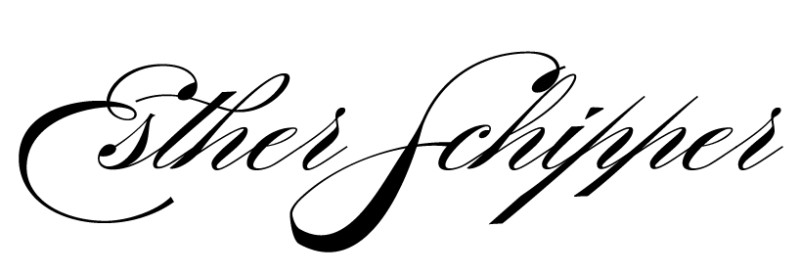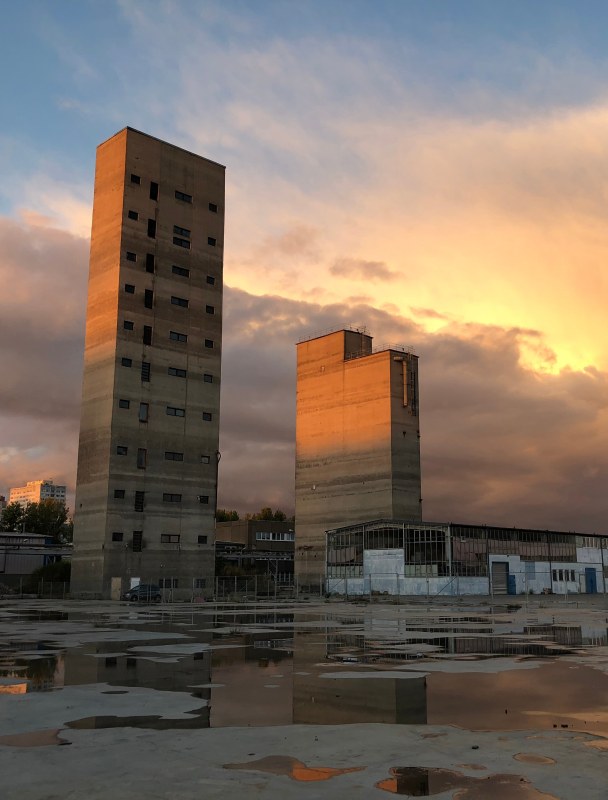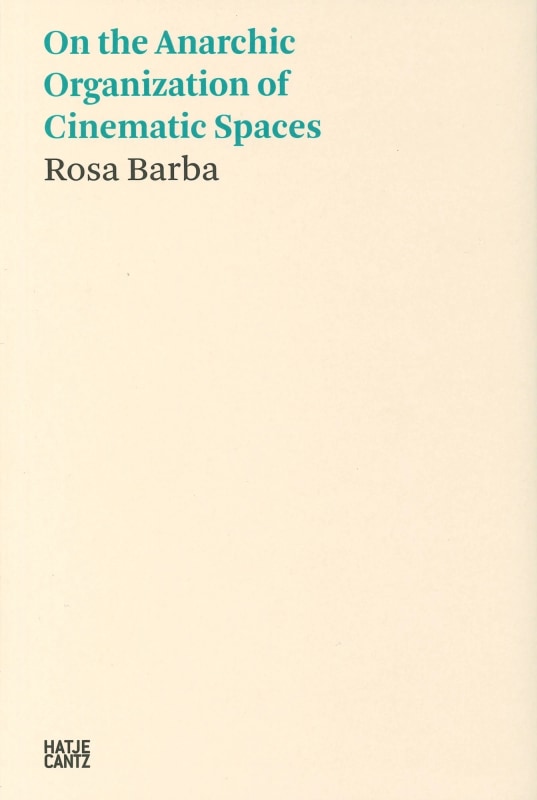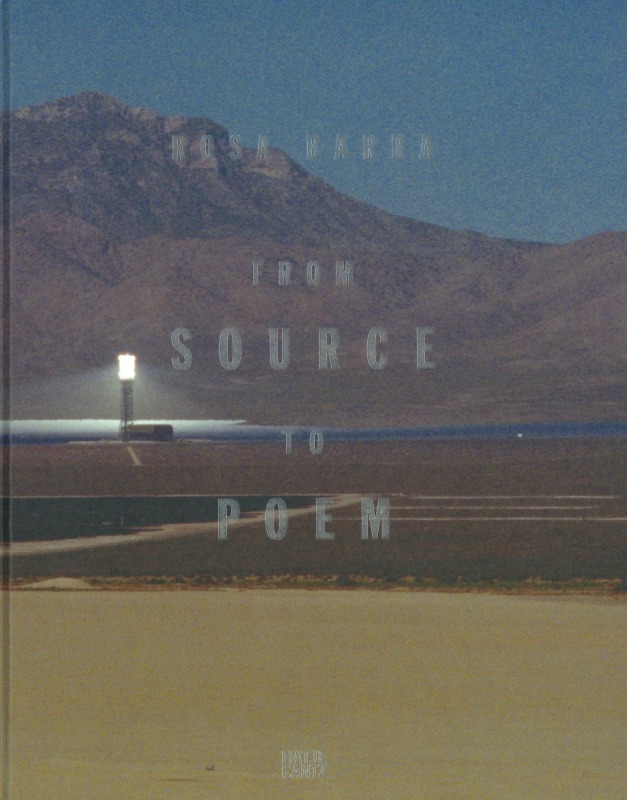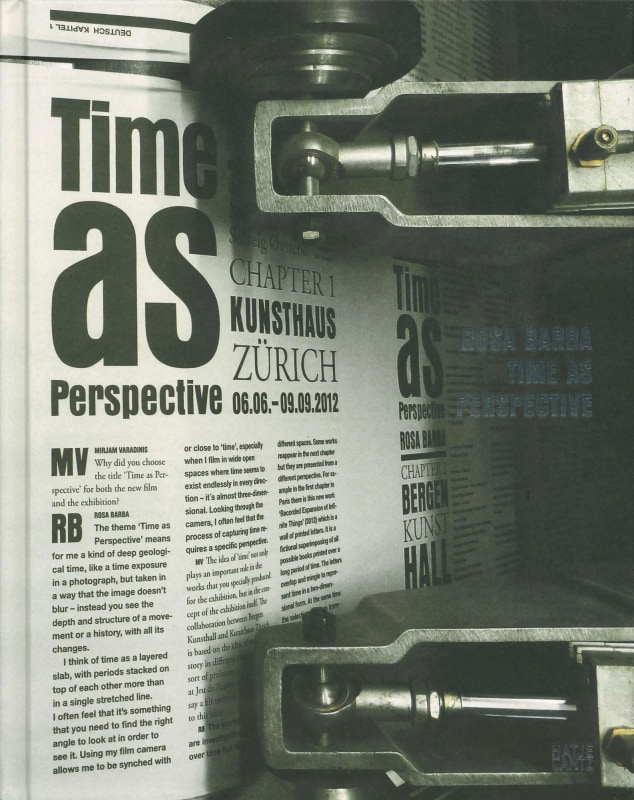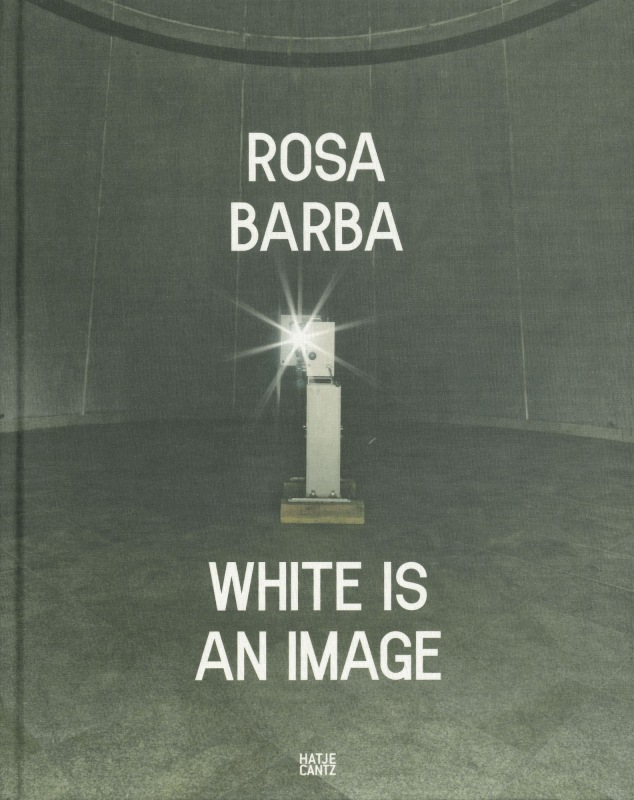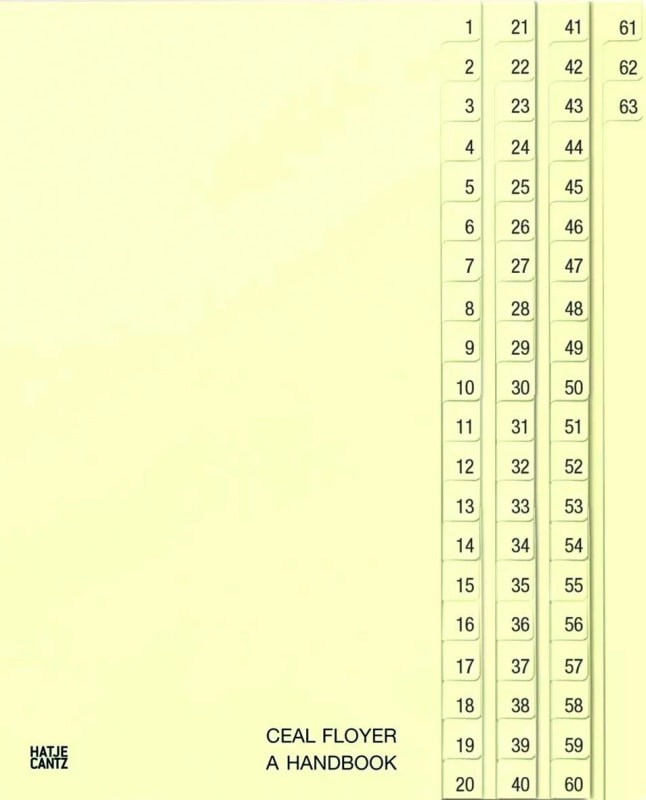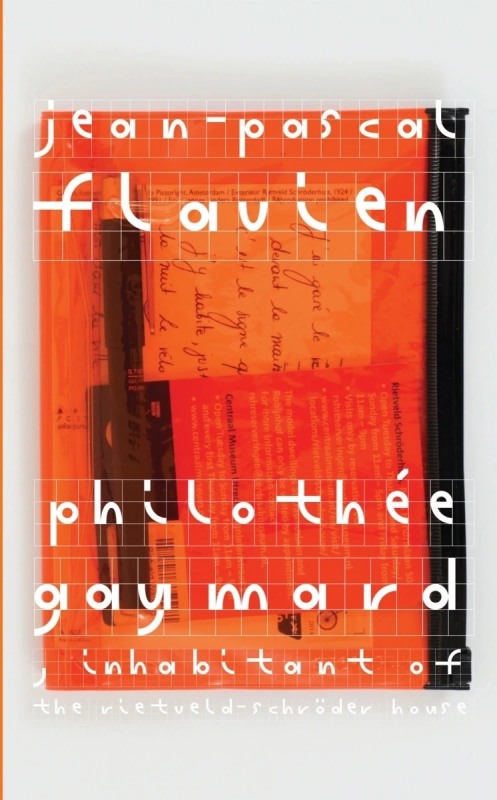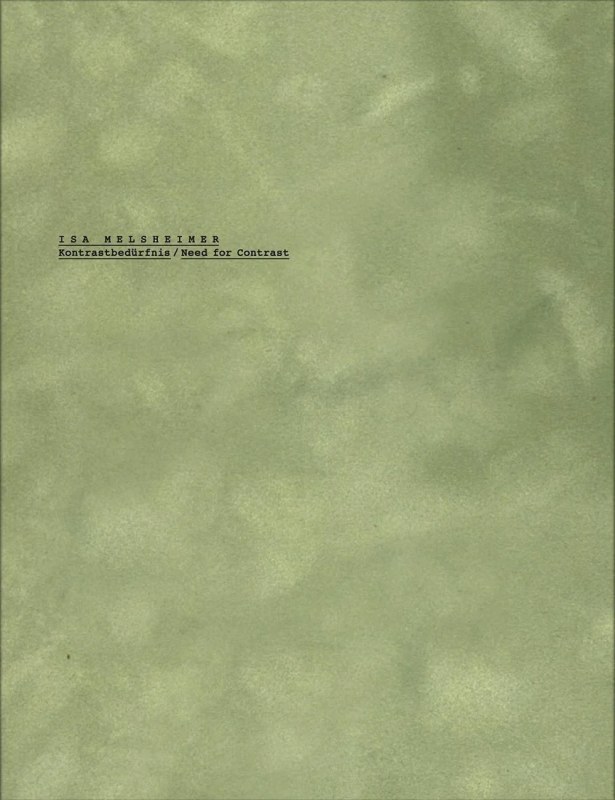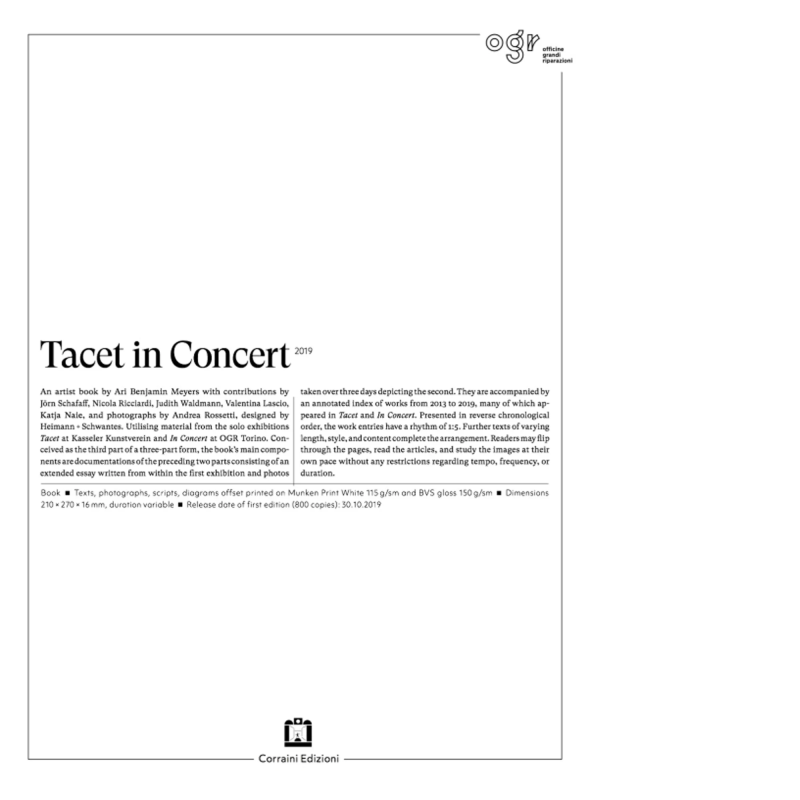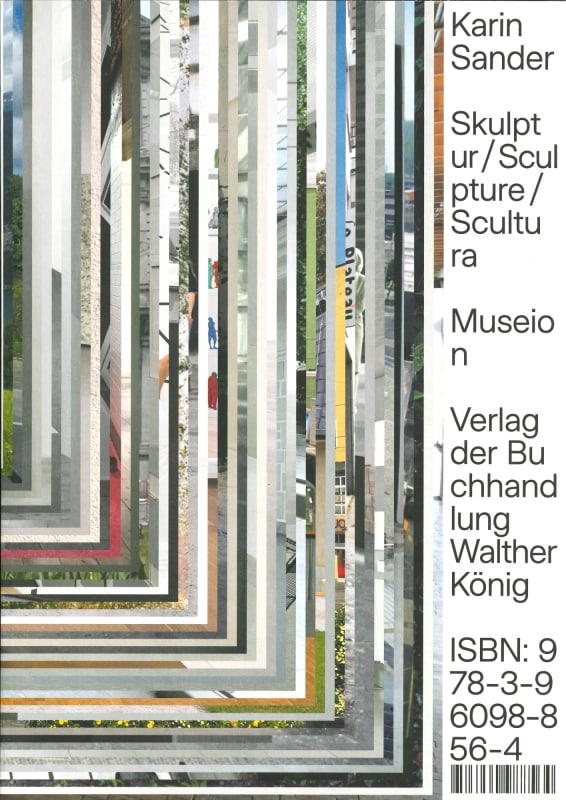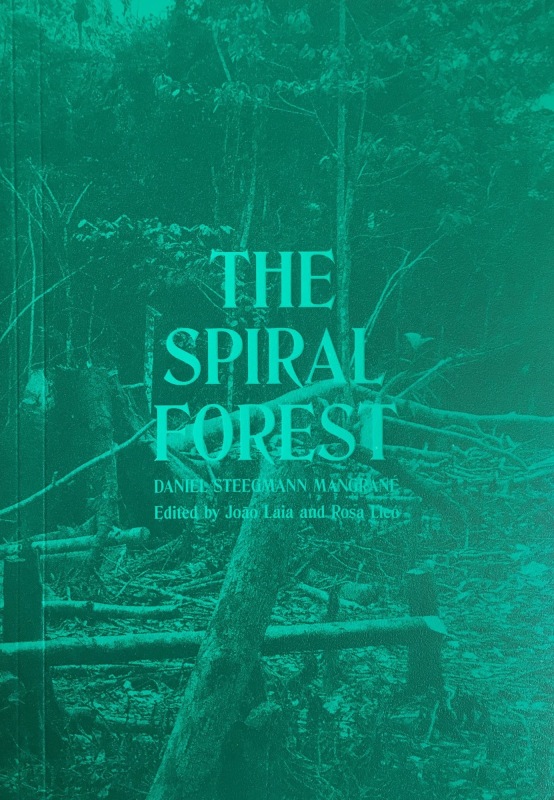Willkommen: Hier finden Sie die deutsche Fassung des Briefes aus Berlin
Welcome to the Letter from Berlin! This edition is all about Berlin Art Week. We begin with Rosa Barba's solo exhibition, Radiant Exposures, which opened at the gallery last week. Below you will find information, exhibition views and a video we produced in which the artist introduces her works. Tonight several of Barba's films will be screened at the Babylon theater as part of their Videoart at Midnight series. Also at the gallery, we currently present historical works by the Brazilian tapestry artists Jacques Douchez and Norberto Nicola. And as part of K60, Isa Melsheimer's work is on view through Sunday at the Wilhelm Hallen. Berlin Art Week is in full swing and below you will find an overview of events and projects by gallery artists, among them Barba, Ceal Floyer, Jean-Pascal Flavien, Ari Benjamin Meyers, and Karin Sander. More information on all ongoing exhibitions in Berlin is available on our website. We conclude with a selection of books on the featured artists. We hope you enjoy your Letter from Berlin!
|
|
|
Special opening hours
Sunday, September 18
11am-6pm |
|
|
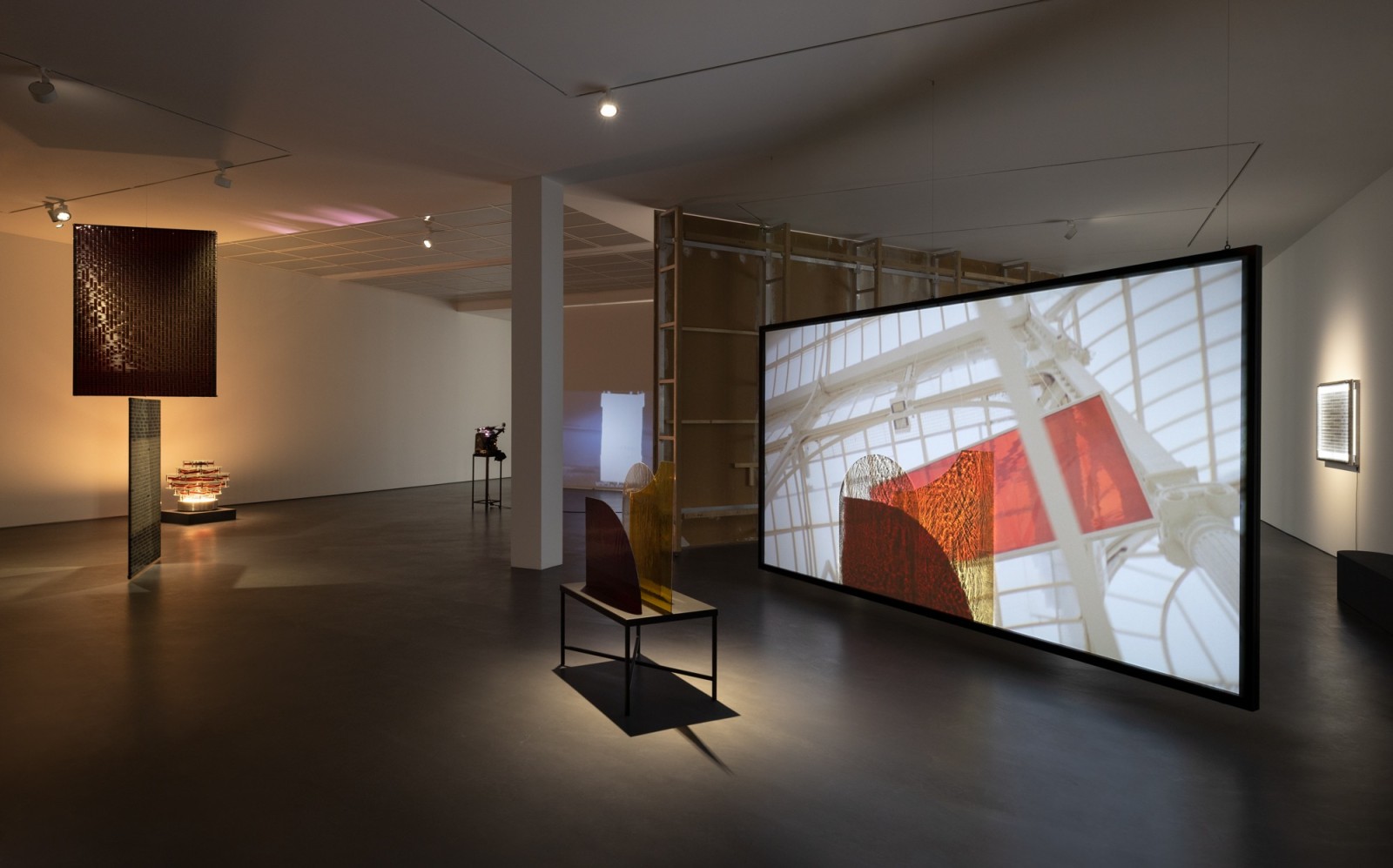
| Exhibition view: Rosa Barba, Radiant Exposures, Esther Schipper, Berlin, 2022. © Rosa Barba / VG Bild-Kunst, Bonn 2022. Photo © Andrea Rossetti | |
|
Rosa Barba engages within the medium of film through a sculptural approach. In her works, Barba creates installations and site-specific interventions to analyze the ways film articulates space, placing the work and the viewer in a new relationship. Questions of composition, physicality of form and plasticity play an important role for the artist as Barba examines the industry of cinema and its staging vis-à-vis gesture, genre, information and documents. Her film works are situated between experimental documentary and fictional narrative. They often focus on natural landscapes and human-made interventions into the environment and explore the relationship of historical records, personal anecdotes, and filmic representation, creating spaces of memory and uncertainty.
|
|
|
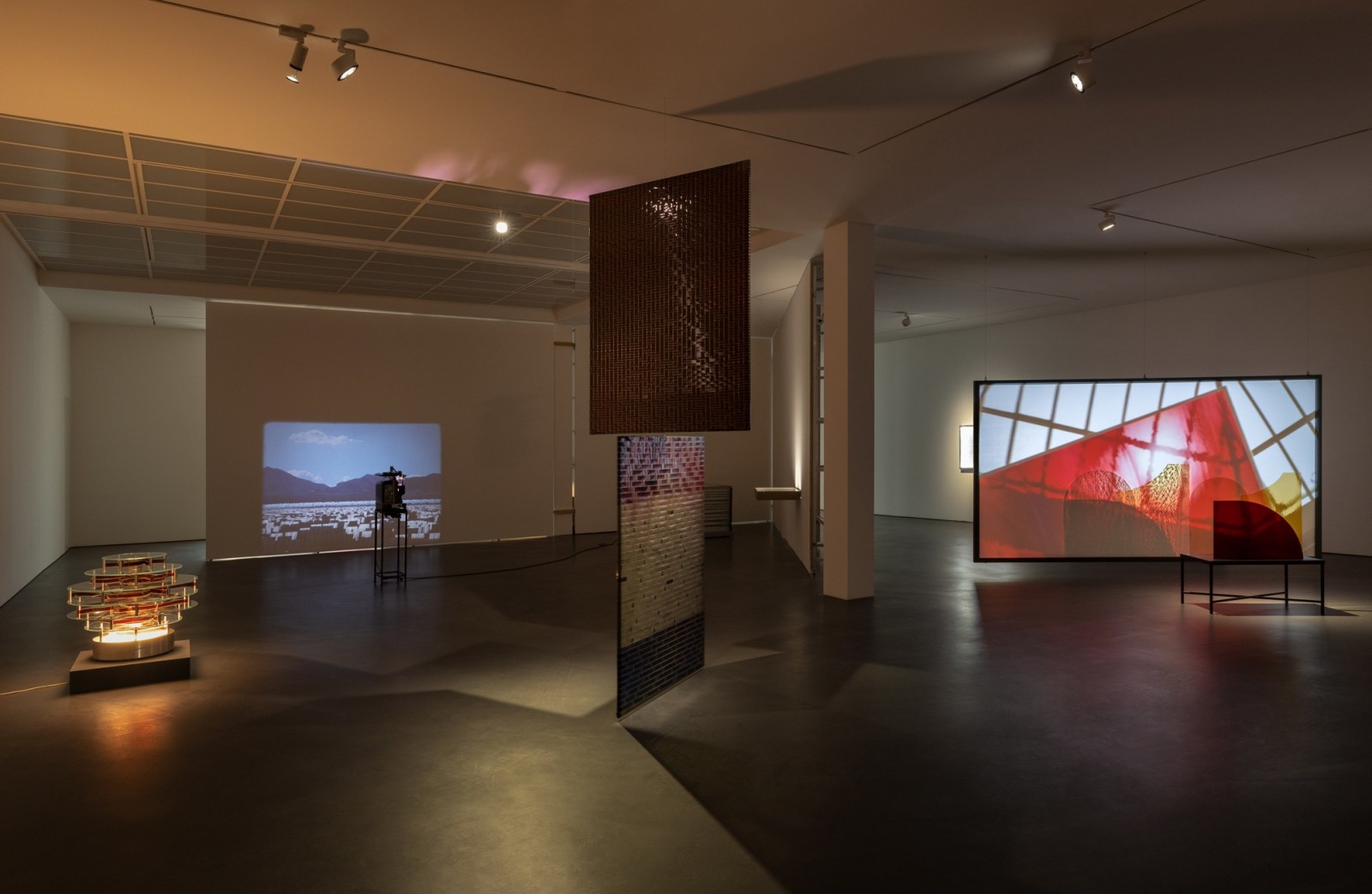
| Exhibition view: Rosa Barba, Radiant Exposures, Esther Schipper, Berlin, 2022. © Rosa Barba / VG Bild-Kunst, Bonn 2022. Photo © Andrea Rossetti | |
|
Radiant Exposures, Rosa Barba’s first solo exhibition with the gallery, includes films and works using film as sculptural and painterly medium. The artist introduces an exhibition architecture with two angled walls that steers visitors through the space and also provides a structure in which Barba’s films are screened and the artist’s sculptural works installed in a carefully orchestrated setting.
|
|
|
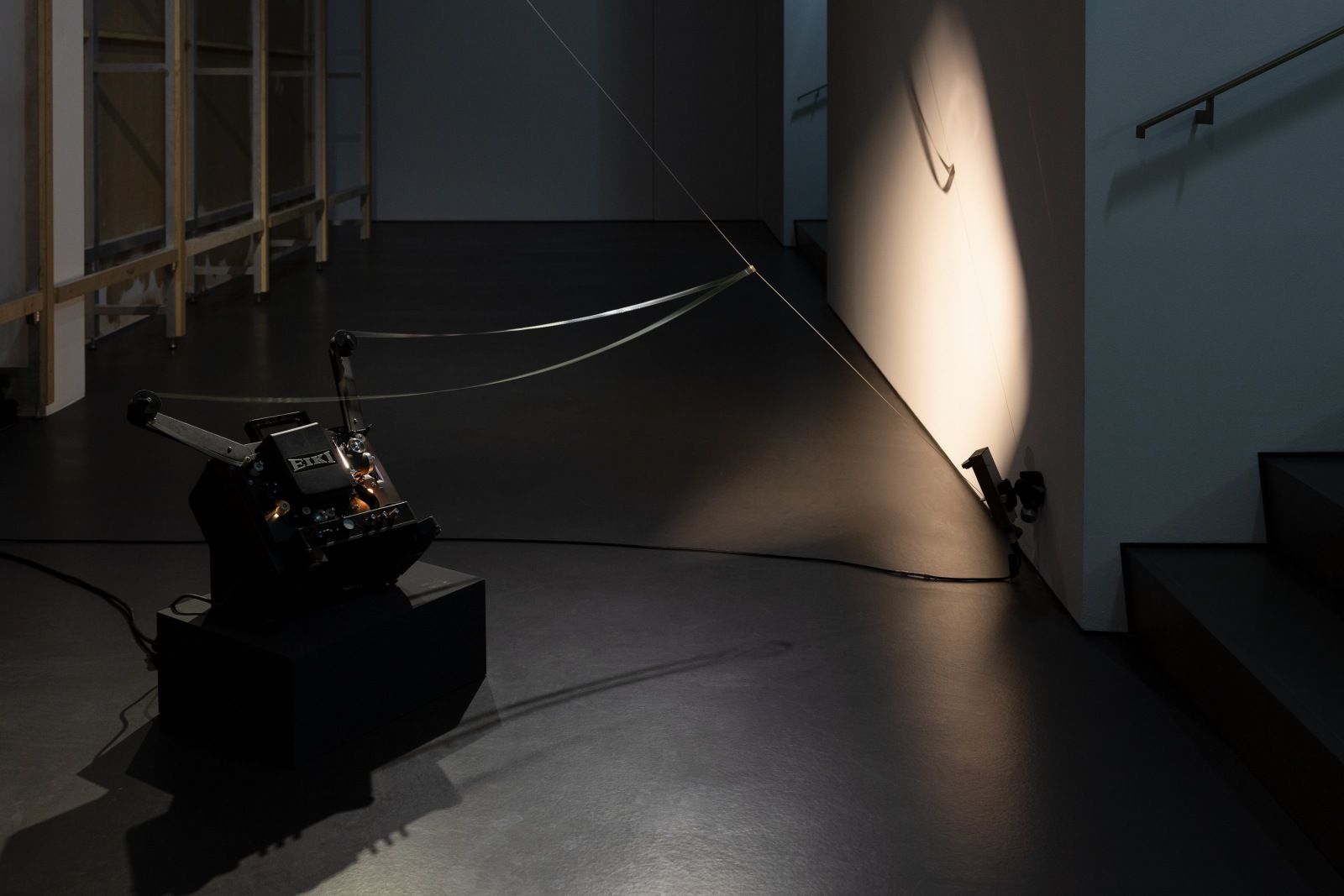
| Rosa Barba, Wirepiece, 2022, 16 mm, projector, drum string, bridge saddle piece, pickup microphone and plinth, dimensions variable. 20 x 40 x 50 cm (plinth)
Exhibition view: Radiant Exposures, Esther Schipper, Berlin, 2022. © Rosa Barba / VG Bild-Kunst, Bonn 2022. Photo © Andrea Rossetti | |
|
Signaling the importance of both film and sound as major themes in Rosa Barba’s practice, visitors will encounter the first—or last—work, Wirepiece, 2022, in the vestibule created by the wall element.
Wirepiece, 2022 consists of a drum string, tightly strung/held between ceiling and the foot of the wall, which is touched—played, really—by a strip of film stock looped through a modified projector. Creating a silvery tone, the piece of celluloid takes on an unexpected role: a medium on which light encodes information, it doubles as a mechanical instrument producing sound. Once inside the space, the sound complements the sonic ensemble created by exhibition’s films, sculptural and performative objects, and “cinematic paintings.”
|
|
|
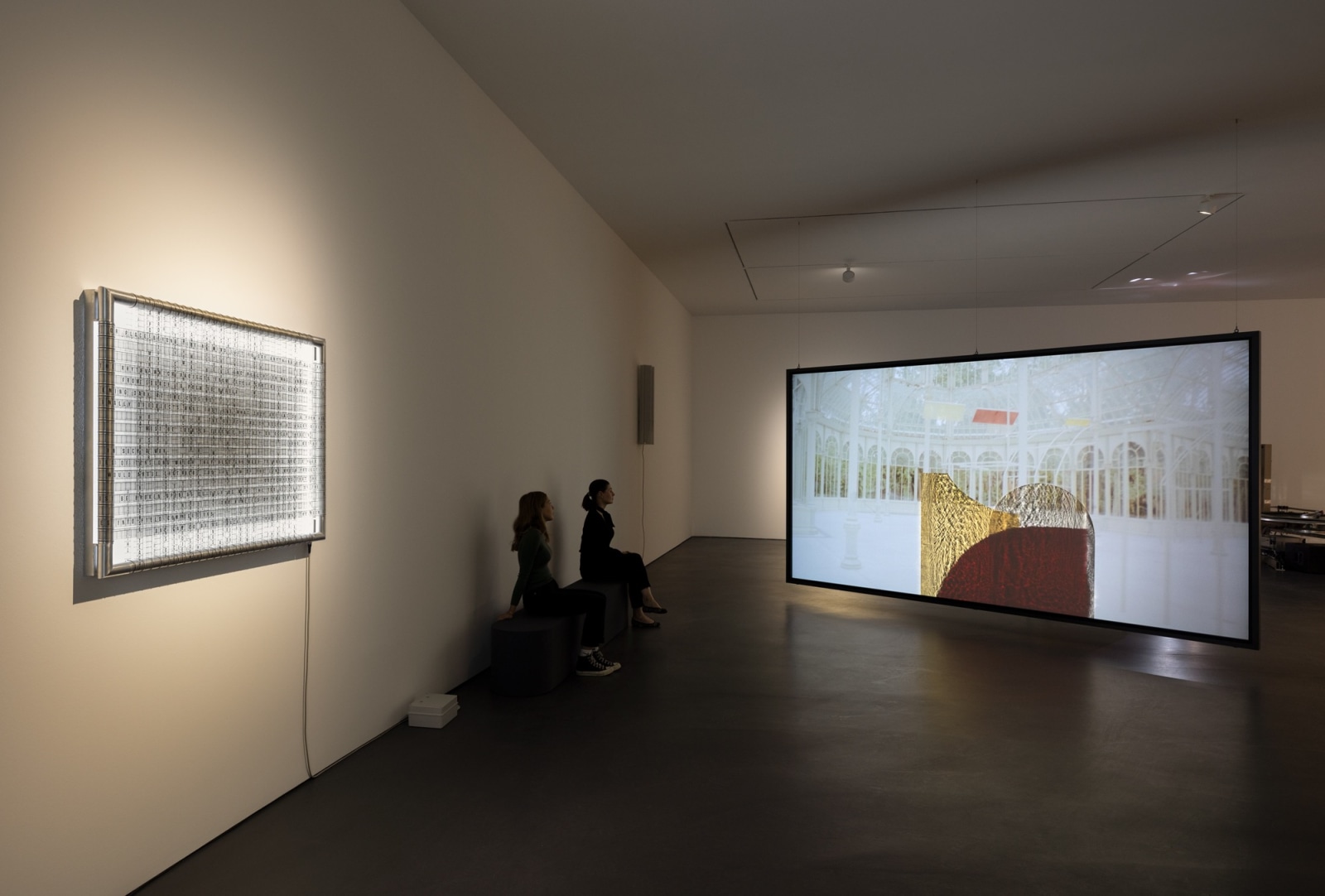
| Left: Rosa Barba, Composition in Field, 2022, 35 mm film, stainless steel, aluminum, motor, Plexiglas, LED lights 90 x 118,8 x 10 cm
Right: Solar Flux Recordings, 2022 (detail), steel table, color glass plates, 35 mm film, projector, looper, duration: 11 min, 130 x 100 x 55 cm (sculpture)
Exhibition view: Radiant Exposures, Esther Schipper, Berlin, 2022. © Rosa Barba / VG Bild-Kunst, Bonn 2022. Photo © Andrea Rossetti | |
|
The film Solar Flux Recordings, 2022 takes a central role in the exhibition. For her 2017 solo exhibition at the Museum Reina Sofia’s Palacio de Cristal, Barba constructed a delicate frame (a reconstruction of the Palacio’s formal vocabulary) inside the nineteenth-century structure and placed shapes with filters high up in its roof. Made from handblown colored glass, the locations of the filters were precisely calculated according to the passage of the sun. The building “became a kind of machine” as Barba noted, in effect turning the entire Palacio de Cristal into a sundial. Solar Flux Recordings, 2022 captures the passage of time through shadows and the movement of the sun produced over the course of the Madrid exhibition. At the gallery, in an echo of its conception, the film is projected through glass filters that emulate the ones Barba installed in the Palacio de Cristal and refract the film as it is projected.
|
|
|
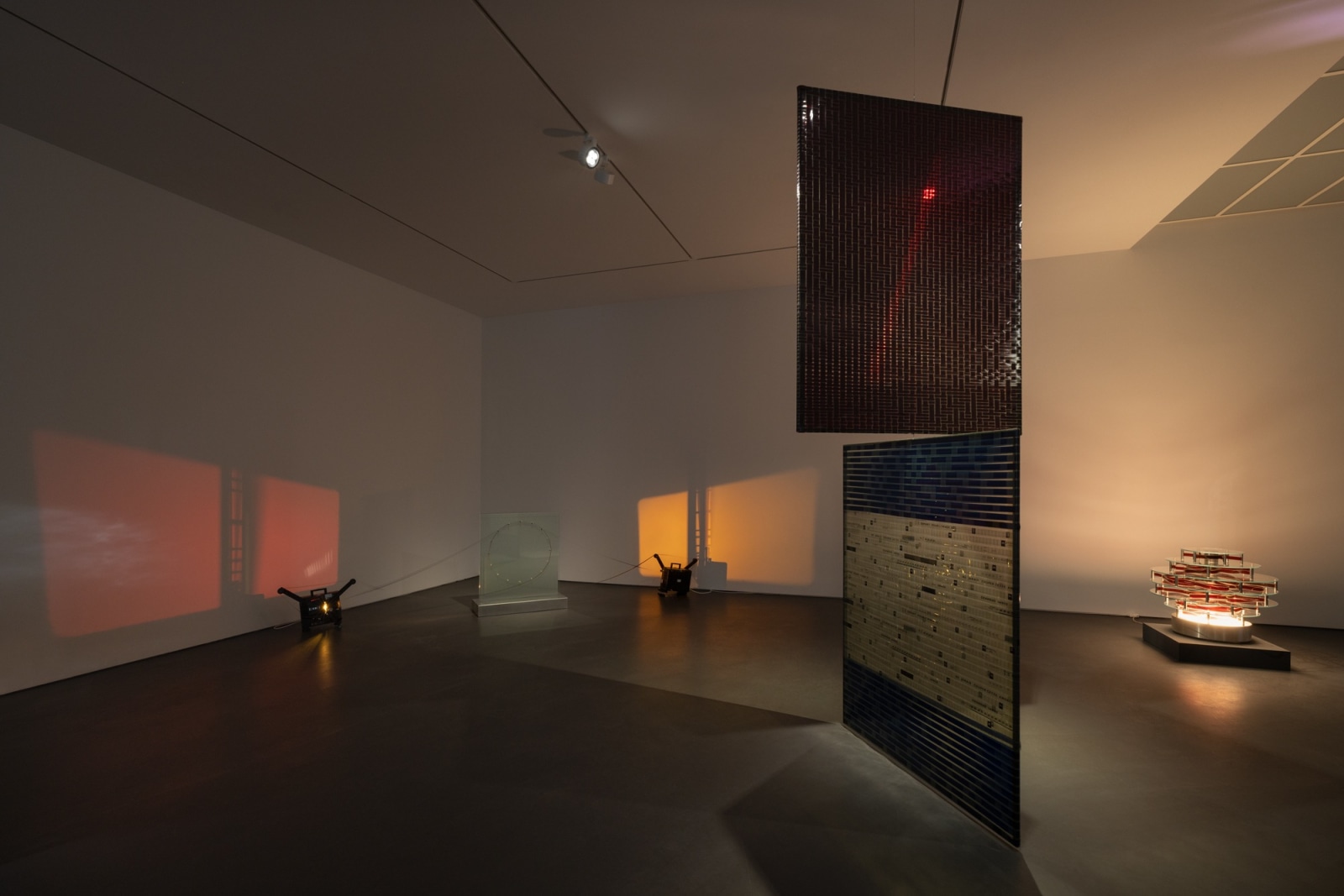
| Exhibition view: Rosa Barba, Radiant Exposures, Esther Schipper, Berlin, 2022. © Rosa Barba / VG Bild-Kunst, Bonn 2022. Photo © Andrea Rossetti | |
|
Cinematic sculptures—such as Color Response, 2022, two projectors that cross their beams of light, traversing an object made from sheets of glass and rollers to project indexes of filmed color filters—manipulate the apparatuses of cinema and submit the machines and the materials to the requirements of their new forms.
Off Splintered Time, 2021, first conceived for Rosa Barba's solo exhibition at the Neue Nationalgalerie in Berlin, also employs celluloid film as a sculptural medium, held in constant motion along several parallel planes. The work consists of 6 glass disks of various diameters stacked on top of one another creating a pyramid-like structure placed atop a light source. Strips of exposed 35 mm film are connected to the sculpture‘s central axis which is activated by a motor. Each section has their own rhythm as the rotating center functions as a spool around which the film strips tighten and loosen as it changes direction. The different levels of moving disks create an engaging dance of color and light, as the red film strips continuously change shape. |
|
|
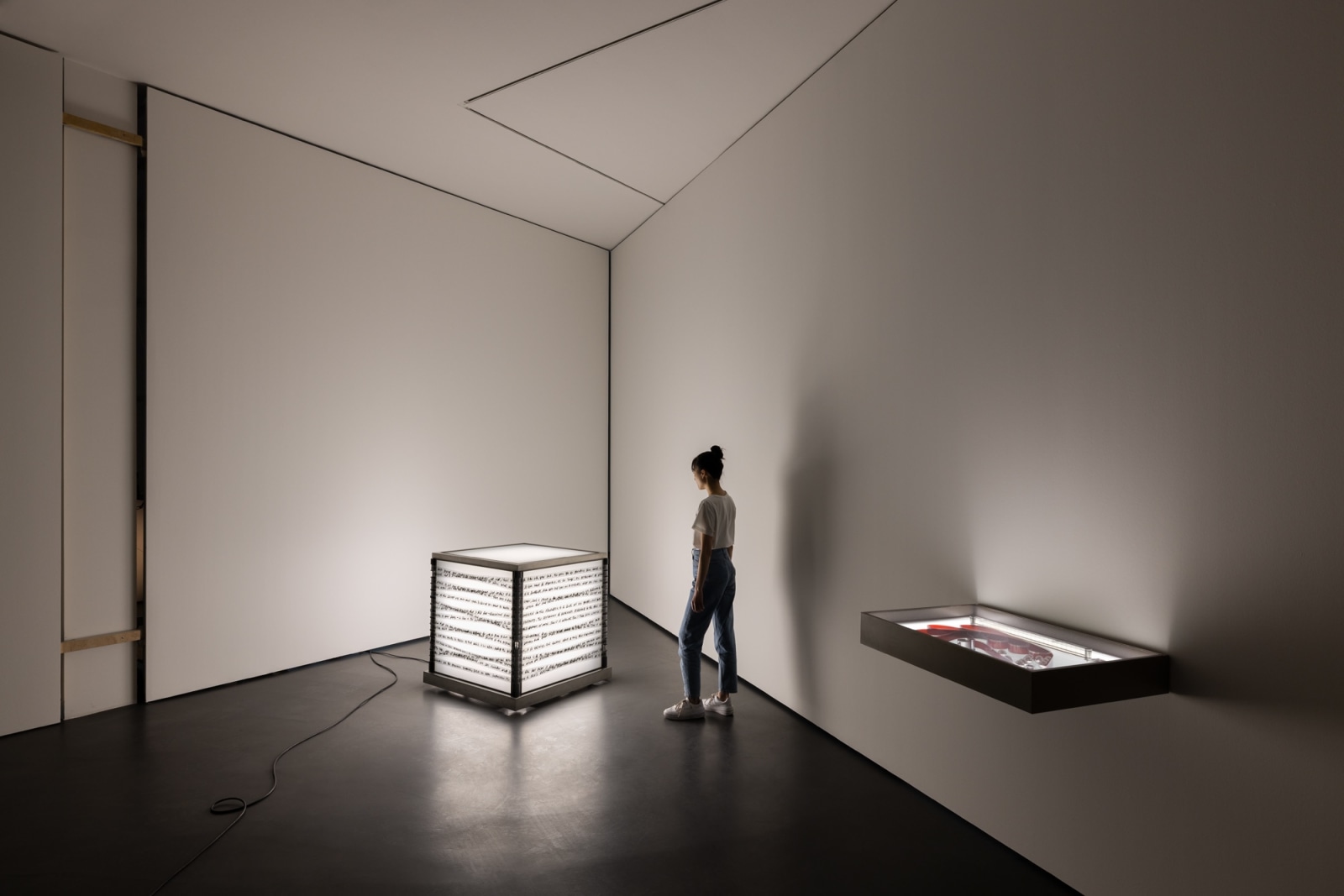
| Centre: Rosa Barba, A Shark Well Governed, 2017, 35 mm film, handwritten with ink, light box, motors, 93 x 93 x 93 cm
Right: Stellar Populations, 2017/2022, 35 mm film, light box, motor, stainless steel spheres, 12,8 x 86 x 60 cm
Exhibition view: Radiant Exposures, Esther Schipper, Berlin, 2022. © Rosa Barba / VG Bild-Kunst, Bonn 2022. Photo © Andrea Rossetti | |
|
In Barba’s practice, time is not treated as a fixed entity, not as a linear expansion. Instead, her work seems to modulate it: time is slowed down in films and broken-up or halted by stuttering apparatuses. The 2017 A Shark Well Governed makes manifest this topic in Barba’s work: Strips of celluloid, with hand-written text with the artist’s speculations on time, move across the sides of an illuminated square light box. The film strips take on a double function as repository of knowledge and as screen through which light becomes modulated.
Some works seem to paint or draw in space: for instance, Stellar Populations, 2017/2022, which in the process of letting film gently propel metal balls, turns their activity into an ever-changing drawing.
|
|
|
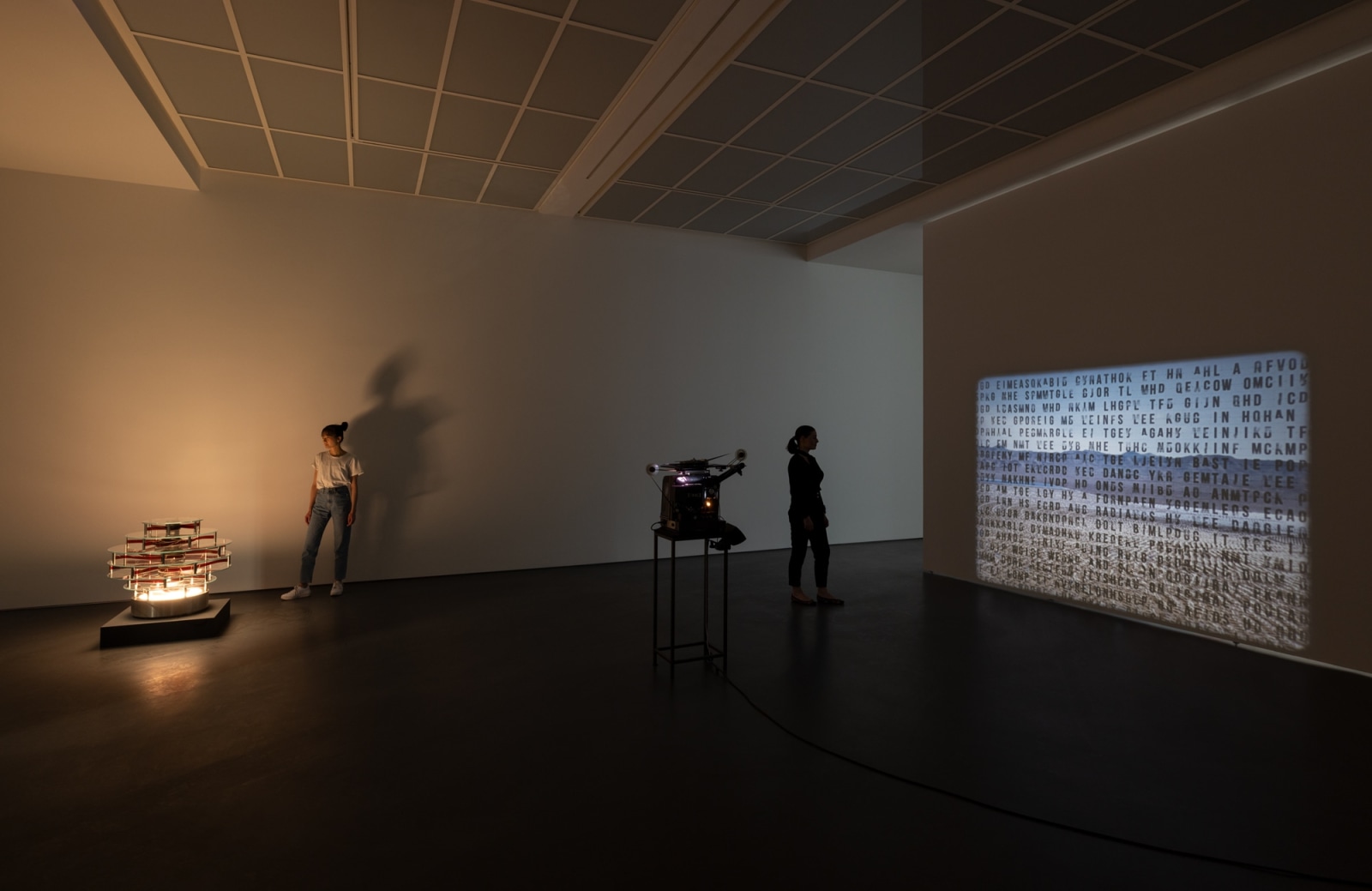
| Left: Rosa Barba, Off Splintered Time, 2021, glass, motors, 35 mm film, LED light, 70 x 80 x 80 cm (sculpture), 15 x 70 x 70 cm (plinth)
Right: Radiant Exposures—Facts Run on Light Beams These Days, 2022, 16 mm film (color, optical sound), dimensions variable, duration: 6 min.
Exhibition view: Rosa Barba, Radiant Exposures, Esther Schipper, Berlin, 2022. © Rosa Barba / VG Bild-Kunst, Bonn 2022. Photo © Andrea Rossetti | |
|
The new 16 mm film Radiant Exposures—Facts Run on Light Beams These Days, 2022, (the latter part of the title quotes from Donna Haraway) returns to Rosa Barba’s long-standing motif of the desert and its exploration of modern archives as a manifestation of human’s desire for progress. As in previous films, Radiant Exposures—Facts Run on Light Beams These Days appears to portray a site out of time and space—ethereal, timeless and unearthly.
The exhibition’s title, Radiant Exposures, alludes to this dichotomy as well: it draws attention to the threshold of creation and destruction at which everything exists. Thus, while the exposure of celluloid must be controlled in order to produce the image—let in too much light into the (analog) camera and the encoded images are lost—this balance also holds true for our existence and the future of the planet, as both “radiance” and “exposure” carry in them a certain threat in times of climatic crises. At the same time, the title also introduces the beauty and timelessness of the cosmos and alludes to Barba’s continued research into the overlaps of film and astronomy.
|
|
|
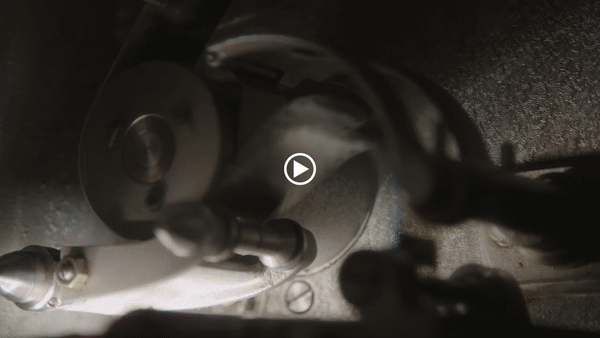
| Just released! Our exhibition film with Rosa Barba - watch hereIn this film Barba discusses the ideas behind the exhibition and takes us through each of the works presented.
| |
|
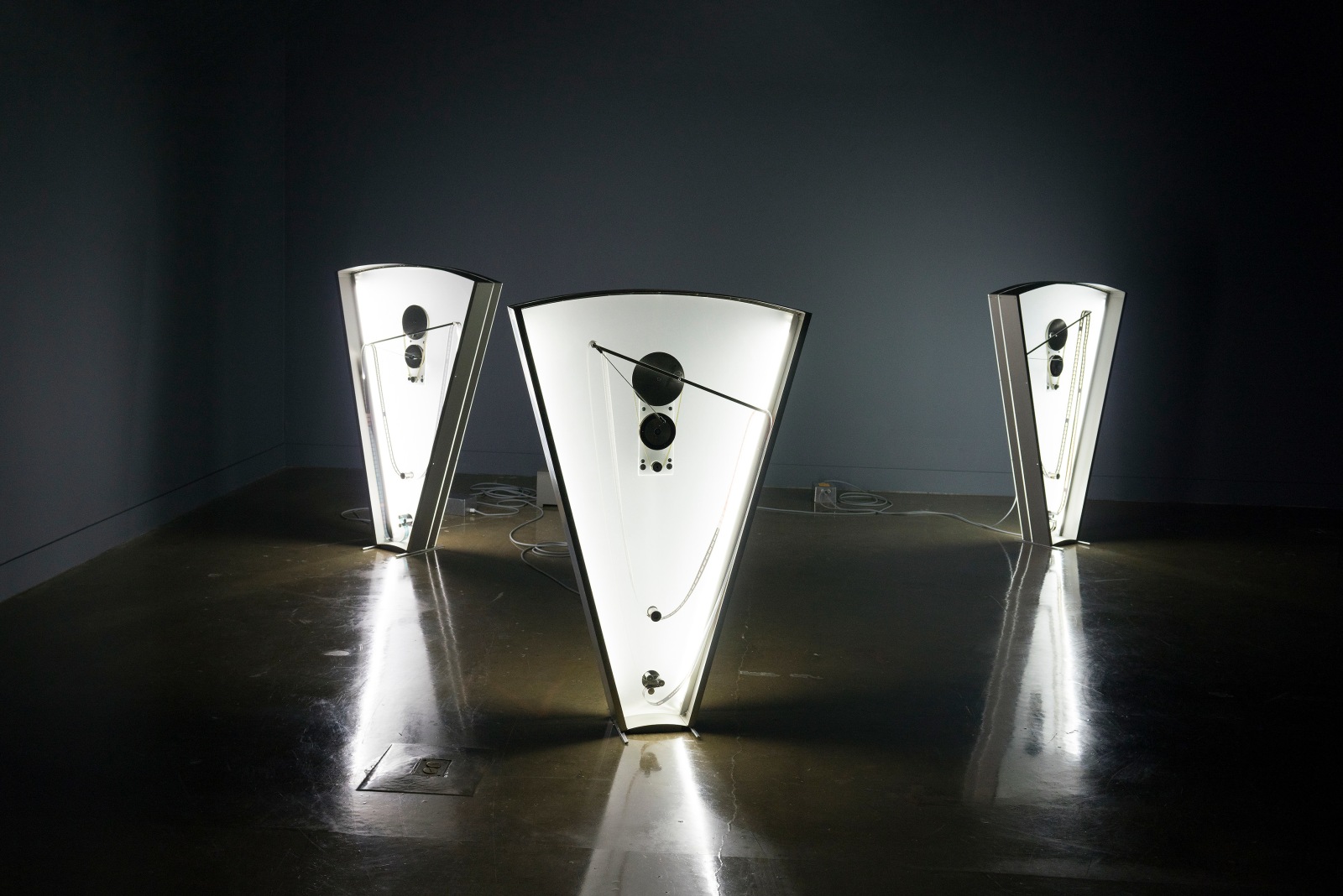
| Rosa Barba, Color Clocks: Verticals Lean Occasionally Consistently Away from Viewpoints, 2012, three film sculptures: 35 mm film, motors, aluminum, Plexiglas,127 x 83 x 46 cm each, 3 parts, installation dimensions variable. © Rosa Barba / VG Bild-Kunst, Bonn 2022
| |
|
At the Villa Medici in Rome, Art Club #36, a presentation of three works by Rosa Barba curated by Pier Paolo Pancotto, opened on September 14, spans over 10 years of her practice that range from film, kinetic sculptures and film sculpture. With Disseminate and Hold, 2016, Barba investigates human-made geographies and landscapes, and how these are often deeply enmeshed with political agendas and utopian visions. The film work introduces the everyday disorder of the Minhocão (or “Big Worm”), the elevated highway that runs through the heart of São Paulo and reflects on the traces that history leaves on the landscape and urban environment. Color Clocks: Verticals Lean Occasionally Consistently Away from Viewpoints, 2012, consists of three objects arranged in the space whose designs are reminiscent of the operation of a clock’s gear mechanism. Each with its own specific rhythm they produce a kinetic image. As a re-collection of timekeeping and the experience of time itself, Color Clocks plays with different modes of perception: a meditation on color, time, perception and language, repeated to infinity. In Weavers, 2021, 16 mm film loops through and around 35 mm film warp, creating a patterned double-sided canvas. The title refers to the collaborative work of the makers of this monumental piece. The irregular weaves accentuated by a low-angled spotlight create fleeting sequences. At times reflective or see-through, Weavers is at once a cinematographic image and a rotating suspended screen. Visitor information
|
|
|
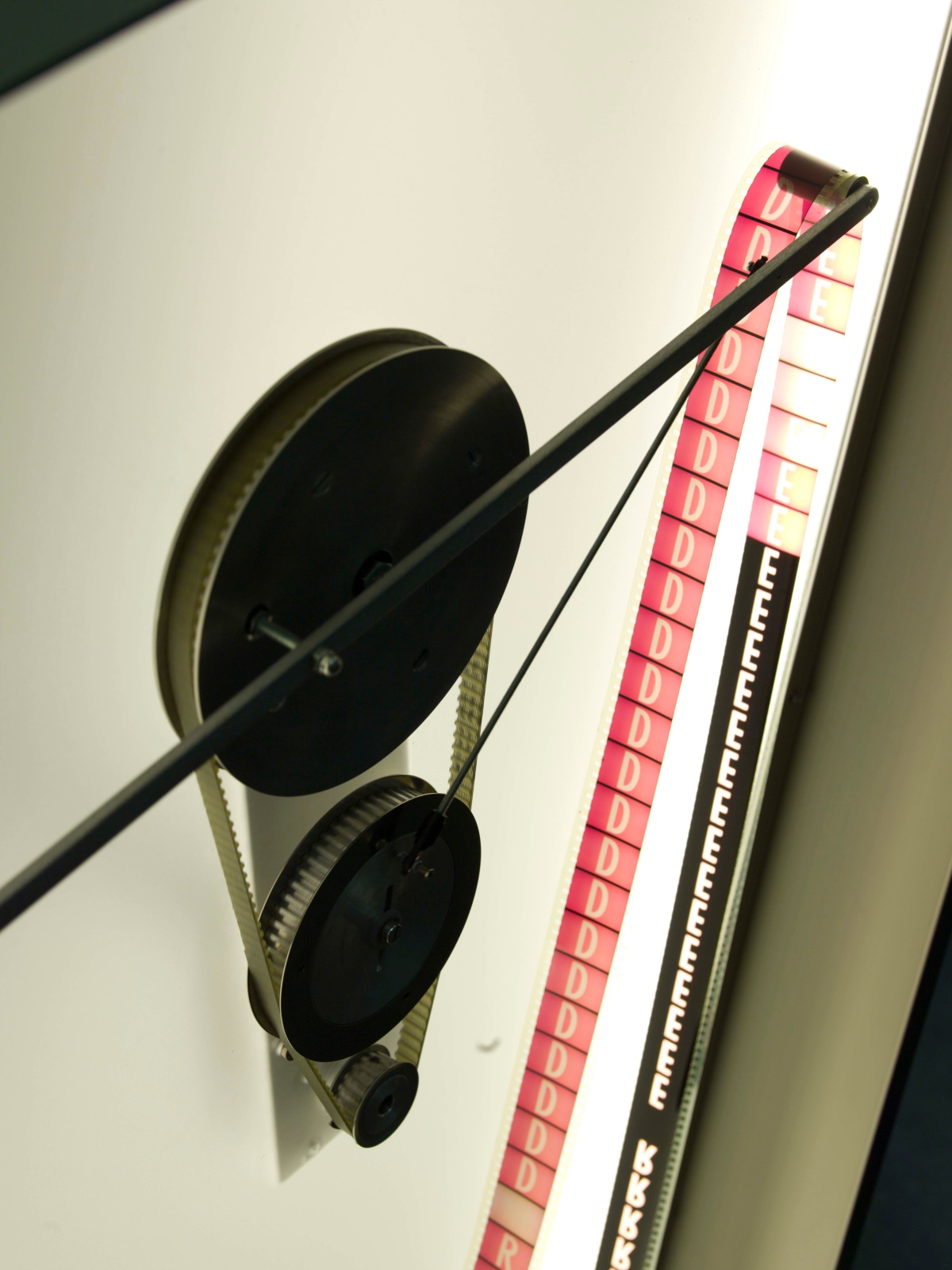
| Rosa Barba, Color Clocks: Verticals Lean Occasionally Consistently Away from Viewpoints, 2012 (detail), three film sculptures: 35 mm film, motors, aluminum, Plexiglas,127 x 83 x 46 cm each, 3 parts, installation dimensions variable. © Rosa Barba / VG Bild-Kunst, Bonn 2022
| |
|
Videoart at Midnight, Berlin
|
|
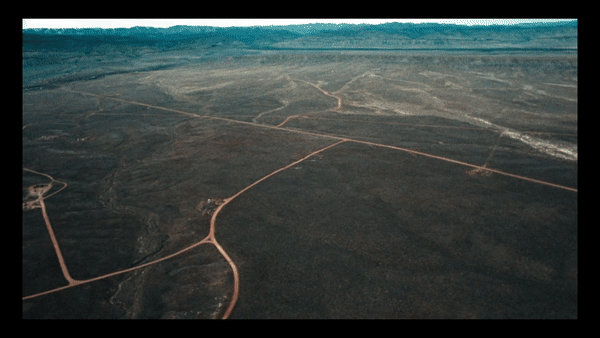
| Rosa Barba, Bending to Earth, 2015 (excerpt), 35 mm film (color, optical sound), duration: 15 min.
© Rosa Barba / VG Bild-Kunst, Bonn 2022
| |
|
Videoart at Midnight — Rosa BarbaBabylon Cinema Big cinema hall Rosa-Luxemburg-Platz 10178 Berlin Friday, September 16th, from 11.59pm Free entry - booking required. Today, Friday September 16th, from midnight until early Saturday morning, Videoart at Midnight welcomes Rosa Barba to Babylon Cinema, with a screening of four of her films. In addition to the screenings, Rosa Barba's film It's Gonna Happen, 2005, will be shown as installation in the entrance of the Babylon theater from 3pm until midnight. The films screened are: Time as Perspective, 2012, 12:06 min Outwardly from Earth’s Center, 2007, 23:39 min Bending to Earth, 2015, 15 min.
Aggregate States of Matters, 2019, 21:14 min More information on each of the four films can be found via our website. |
|
|
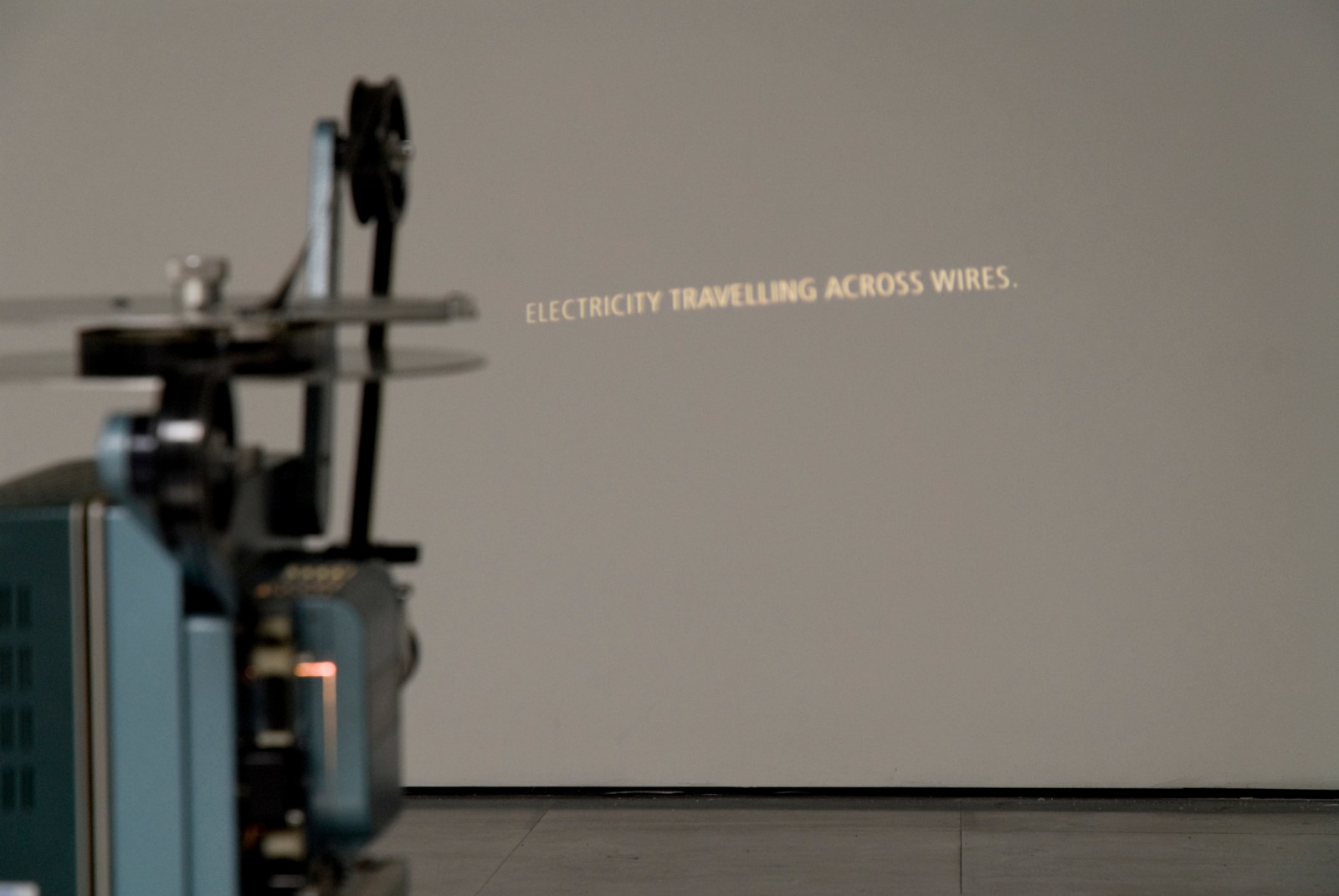
| From 3pm-midnight Rosa Barba's It's Gonna Happen, will be shown in the entrance of the Babylon Theater.
Rosa Barba, It's Gonna Happen, 2005, 16 mm film, color, optical sound; 3 min. Exhibition view: David Roberts Foundation, London, 2010. © Rosa Barba / VG Bild-Kunst, Bonn 2022.
It's Gonna Happen is made up of subtitles describing a night scene in a fictional city. The soundtrack to this imageless cinema comprises a conversation between a president and his assistant, a mysterious plot that somehow rhymes with the dialogue in the film's subtitles. The piece imbues the space with enigmatic plots where the future becomes a black hole and creates new possibilities. Cinema is present, not in its cinematographic imagery but rather in the divide of Off- and On-Screen reality, its means of production, its materiality imprinted on itself.
| |
|
Jacques Douchez & Norberto Nicola
|
|
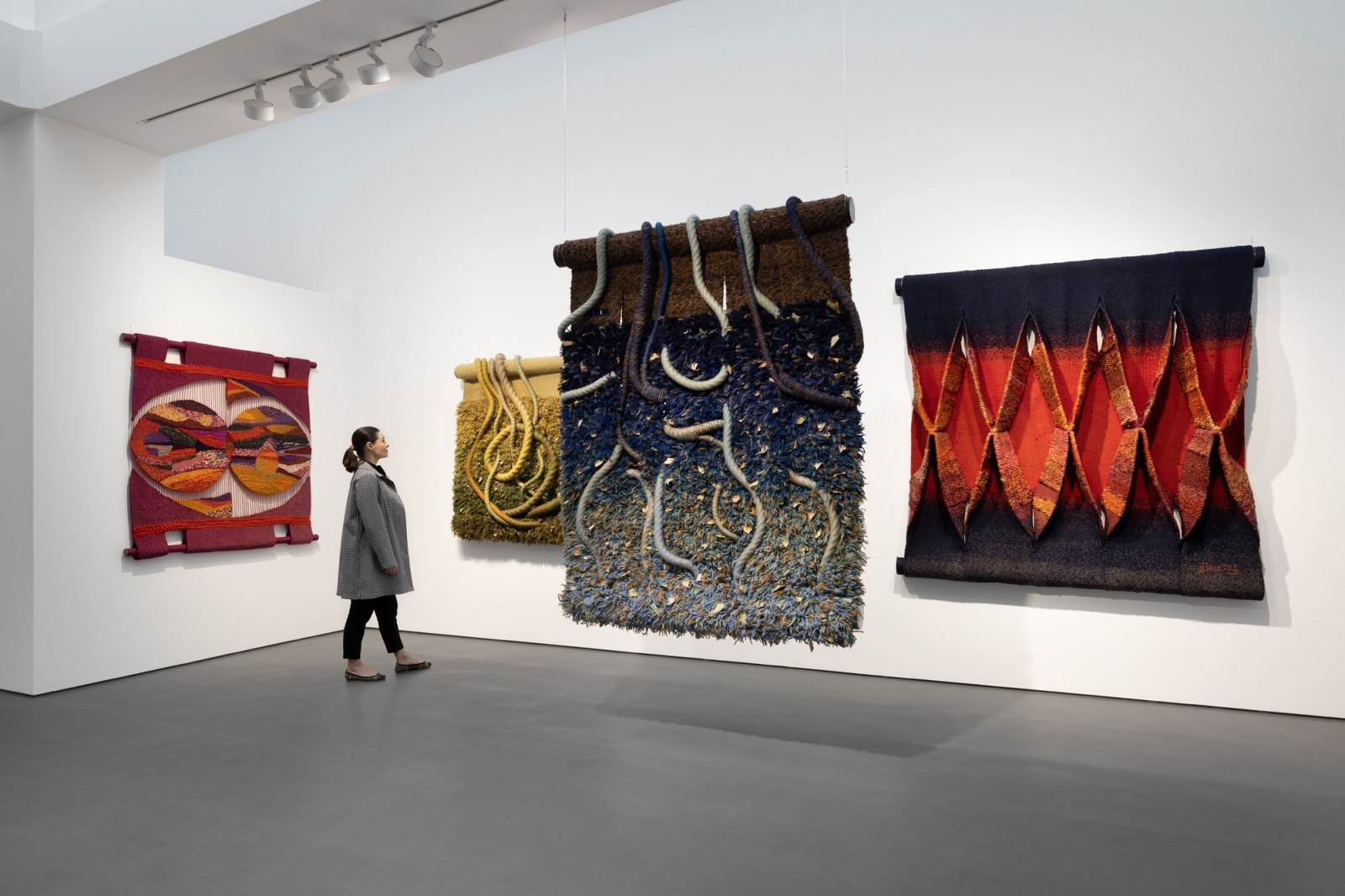
| Exhibition view: Jacques Douchez and Norberto Nicola, Esther Schipper, Berlin, 2022.
Photo © Andrea Rossetti | |
|
Jacques Douchez & Norberto Nicola
Esther Schipper Potsdamer Straße 81E 10785 Berlin Through October 15, 2022 www.estherschipper.comPlease note that on Sunday, September 18 Esther Schipper will be open especially for Berlin Art Week, 11am-6pm.On view is a special presentation with historical works by Jacques Douchez and Norberto Nicola, organized with Olivier Renaud-Clément. Jacques Douchez and Norberto Nicola operated a collective studio, Atelier Douchez-Nicola, from 1959-1980 which came to represent a significant step in the development of contemporary art in Brazil.
|
|
|
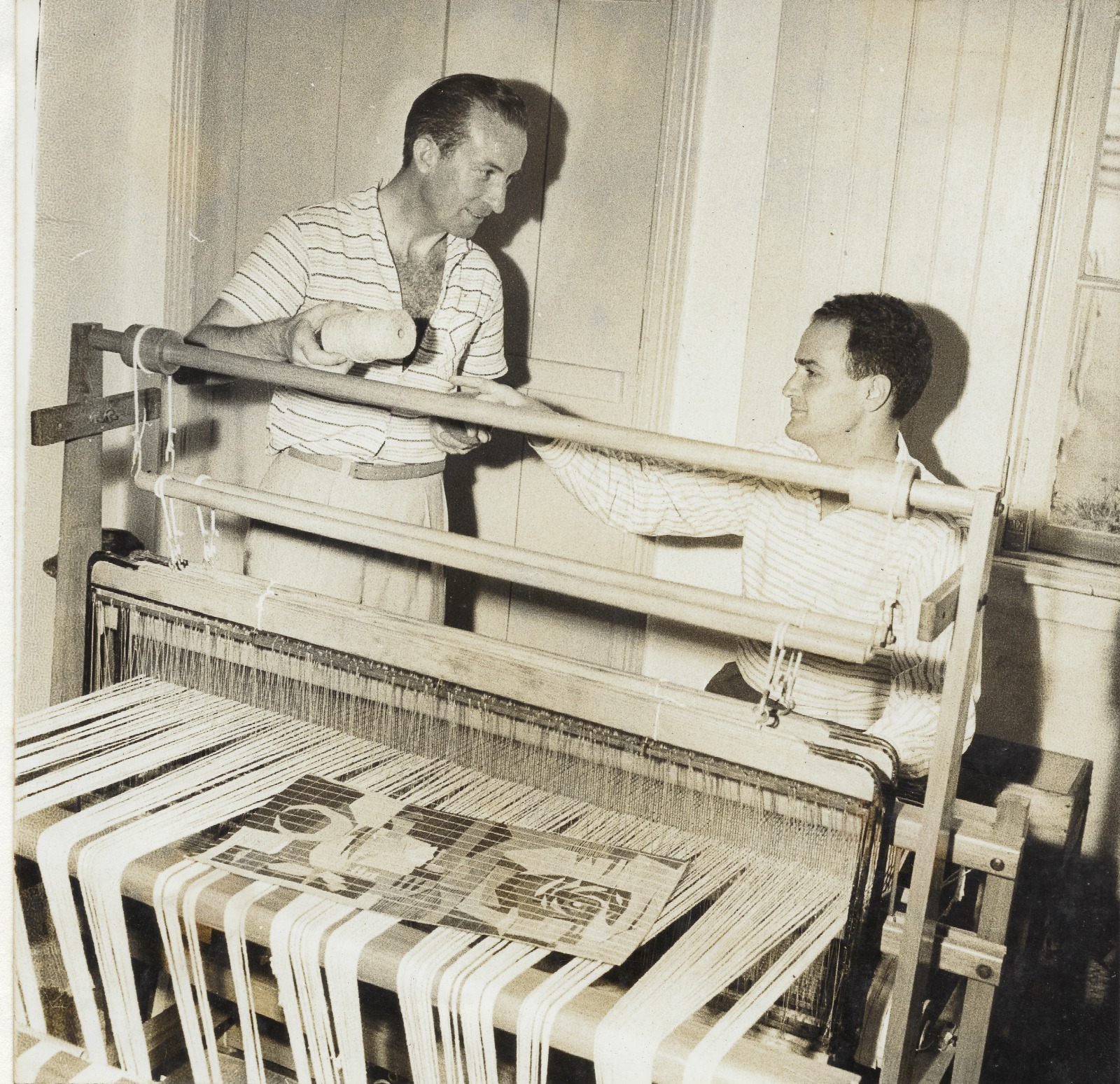 | The two artists at Atelier Douchez-Nicola, 1960s | |
|
In artistic dialogue with international innovators such as Magdalena Abakanowicz and Jagoda Buić, Douchez and Nicola broke with local and Western tradition to create three-dimensional tapestries. Texture, mixed media, and intentional incisions complement the artists’ painterly skills of color and line, creating a whole new kind of “woven object” as the artists’ referred to their works in their 1969 manifesto Formas Tecidas (Woven Forms). |
|
|
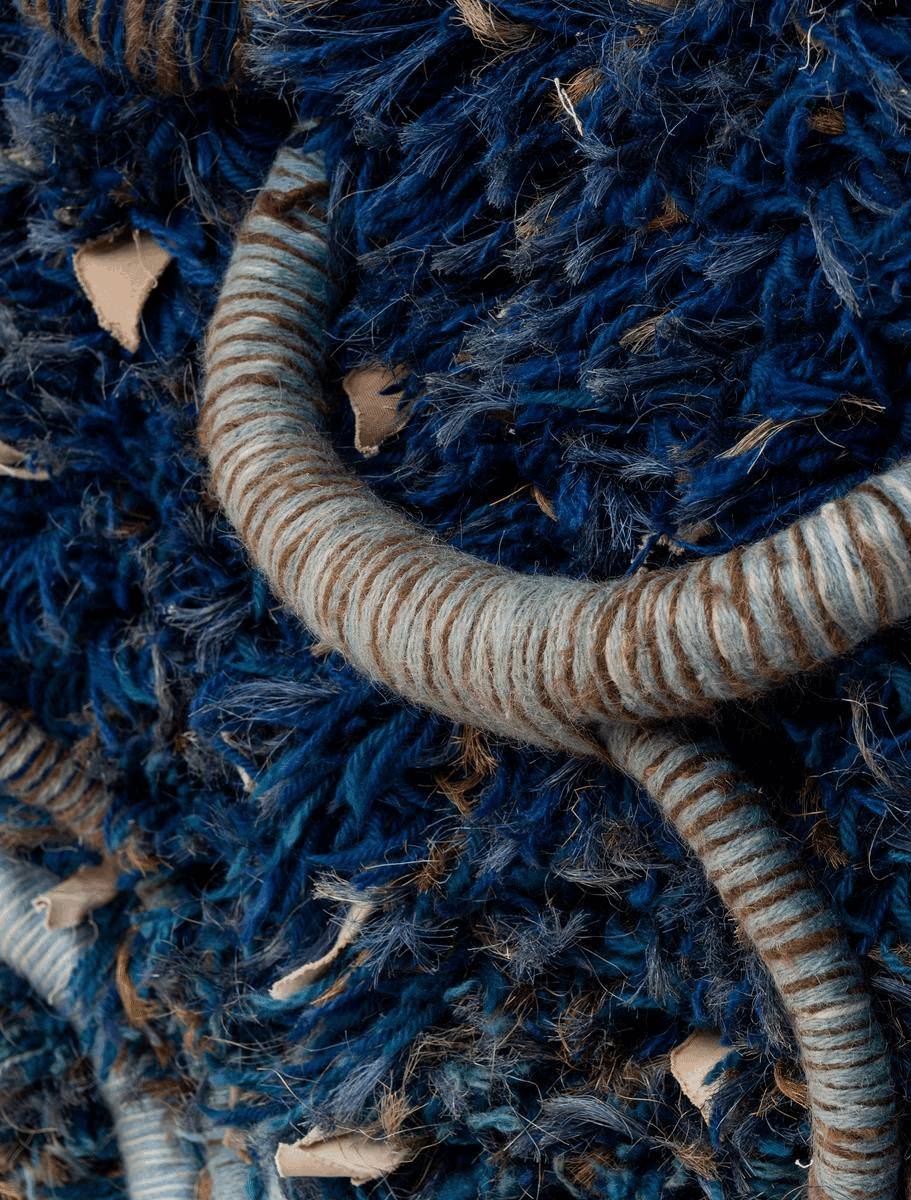
| Norberto Nicola, Rebentos da Noite, 1986, wool, natural fibers, pigments, 182 x 142 cm.
Photos © Ding Musa
| |
|
Rebentos da Noite is a multimedia tapestry, combining wool, natural fibers, and pigments. In the early 1980s, Norberto Nicola's tapestry practice was driven by an investigation into weaving as a narrative medium. In each work, the treatment of the material, its texture, shapes, and colors inscribe a scene or an event. In Rebentos da Noite [Sprouts of the Night] (1987), the color is nocturnal and obscure, and the different shades of blue simulate the continuity of life, the birth of "sprouts", which come forth and project themselves to the exterior along with structures similar to lianas. Germinating from the soil and remaining rooted in it throughout their lives, lianas are found throughout the world with many beautiful examples across the Amazon. Small pieces of cloth, sprinkled throughout the tapestry, create the starry sky of the piece to which the title alludes.
This work was included in the retrospective Norberto Nicola: Tapeçaria Contemporânea [Contemporary Tapestry] at the Pinacoteca do Estado de São Paulo (2009), and was exhibited in the Frederiksberg Town Hall in Copenhagen (1986). It is also featured in the key catalogue on Nicola’s work, Trama Ativa, published by the Pinacoteca do Estado de São Paulo in 2013.
|
|
|
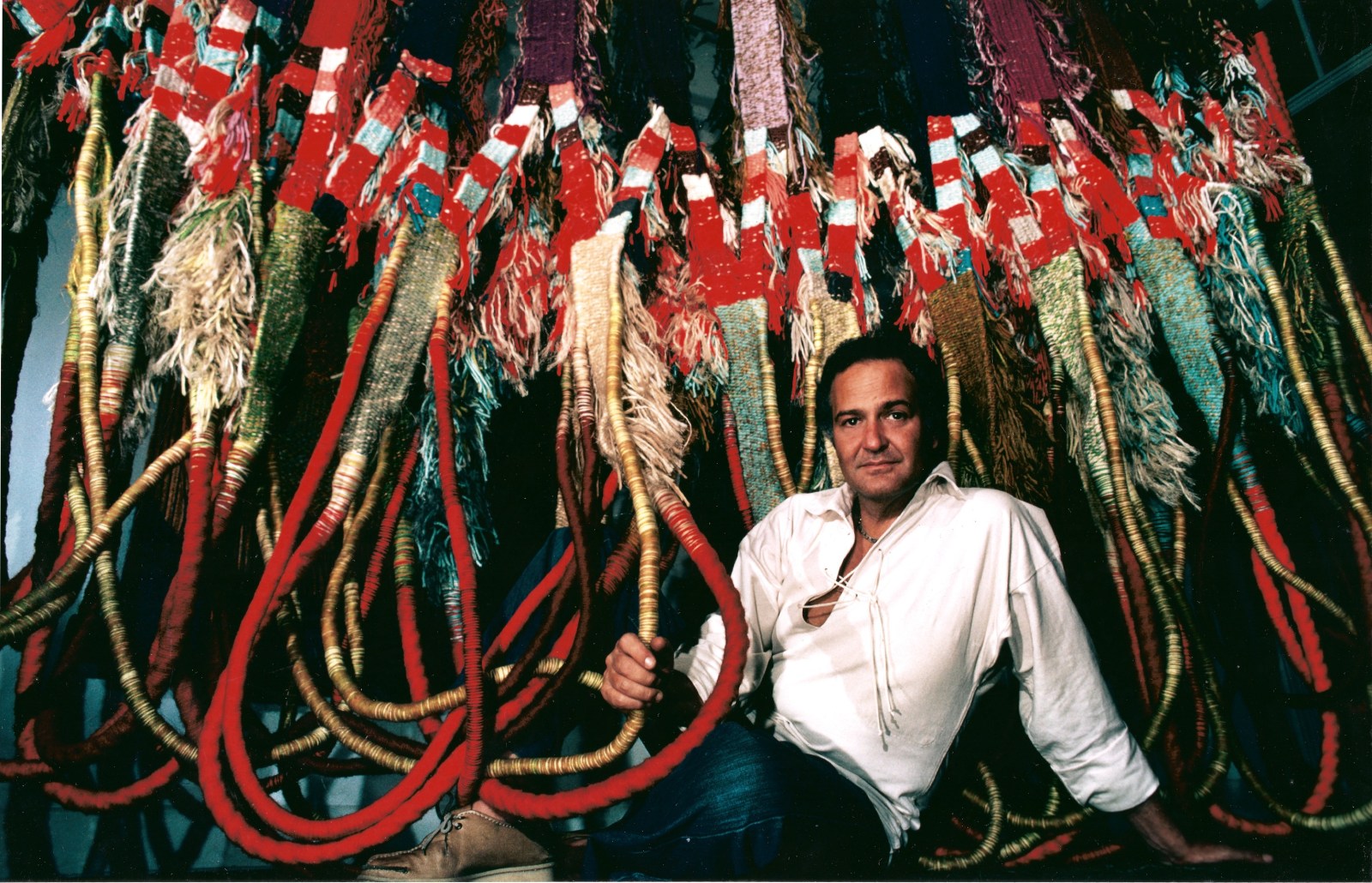
| Nicola in Buenos Aires, May 1978. Photography by Nicholas de Vore
| |
|
Central to Norberto Nicola’s textile practice are the qualities of flexibility, tension, and elasticity, which the artist sought to capture in his work, as well as the use of mixed media. In addition to drawing on his training as an abstract painter, works by Nicola demonstrate the importance of intuition and touch. Sourcing all materials from within Brazil, Nicola studied techniques and gathered natural fibers used by different indigenous communities throughout the country. He was a particularly passionate student of the feather art of indigenous communities of the Amazon, such as the Urubu-Kaapor and Tapirapé and curated important exhibitions on the subject.
|
|
|
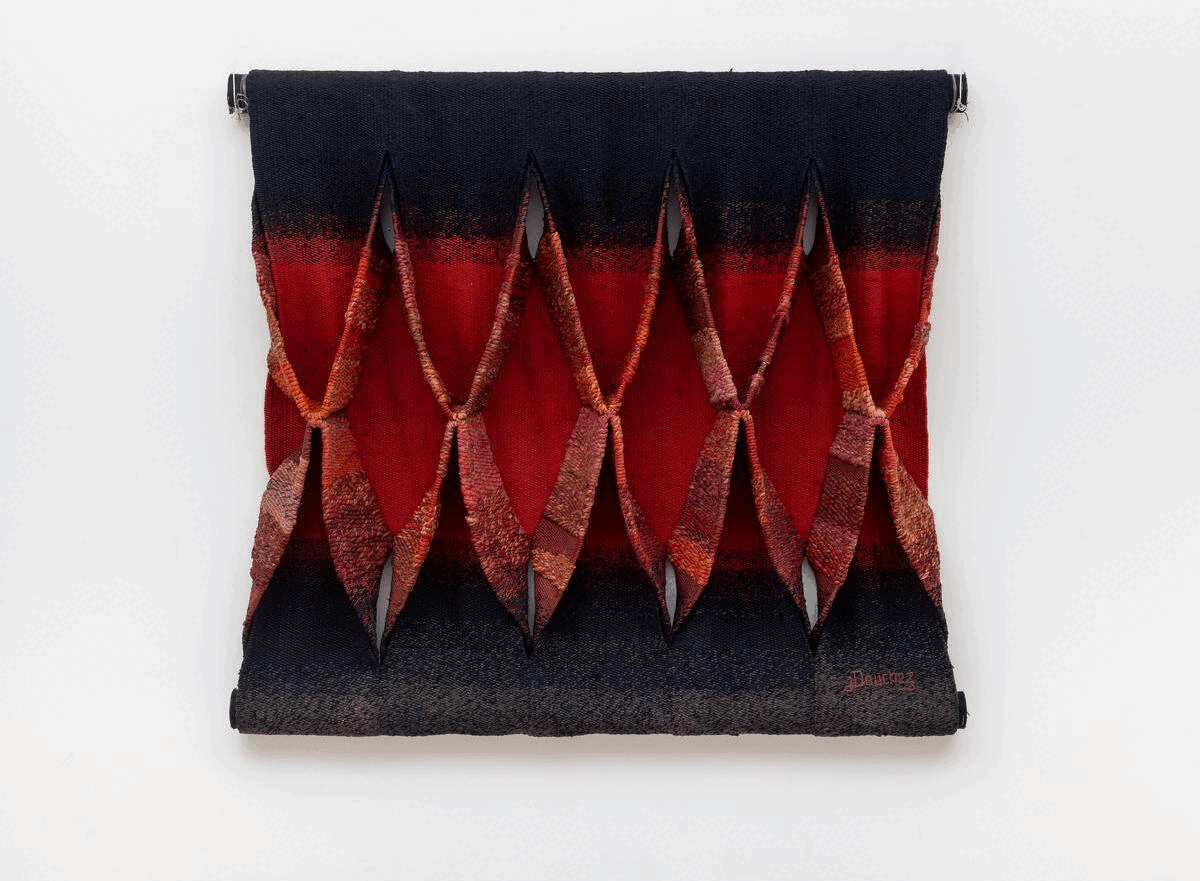
| Jacques Douchez, Untitled, 1970s, wool, natural fibers and pigments, 180 x 200 cm
Photos © Ding Musa
| |
|
For Jacques Douchez, artistic tapestry combines his early fascination with the medieval textile arts of Cluny and the conceptual and technical rigor learned in painter Samson Flexor’s highly influential Atelier-Abstração.
This untitled work from the 1970s was created by Jacques Douchez during the period of the shared Atelier Douchez-Nicola (1959-1980). Works of this period were woven by the artists, in cooperation with the most preeminent weavers on the best looms in Brazil, with both Douchez and Nicola intensely interested in experimenting with different media and techniques.
A multimedia tapestry, Untitled (1970s) combines wool and natural fibers in an imposing highly structured composition. Inspired by medieval tapestry as well as modernist abstraction, Jacques Douchez’s textile works are characterized by their harmonious forms and daring three-dimensional construction. The firm sculptural elements put this work in clear conversation with the formal rigor of contemporaries like Lucio Fontana and Magdalena Abakanowicz.
|
|
|
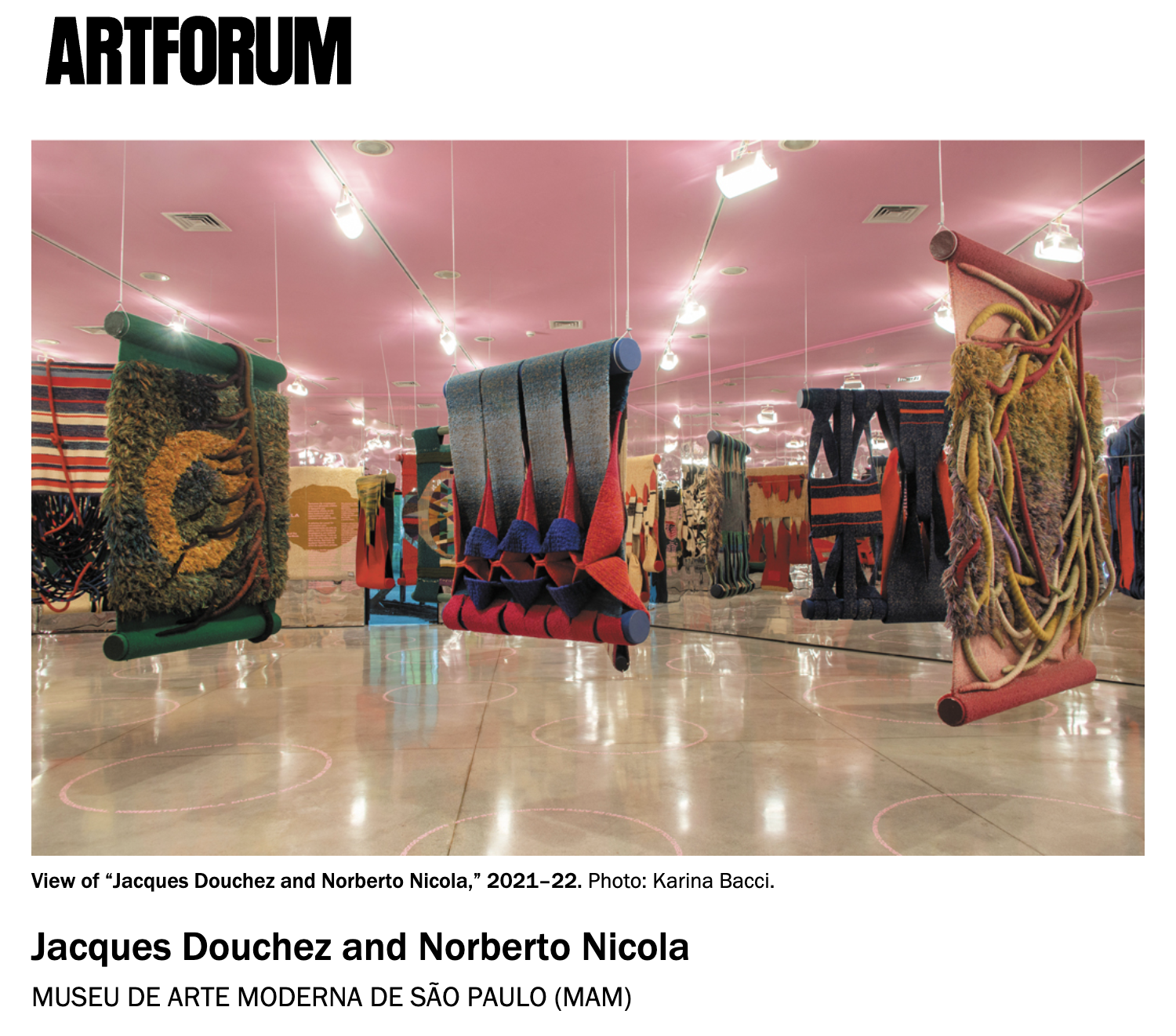
| The work of Jacques Douchez and Norberto Nicola was the subject of a major survey exhibition at the Museu de Arte Moderna de Sao Paulo this year. Read the review in Artforum. Read here
| |
|
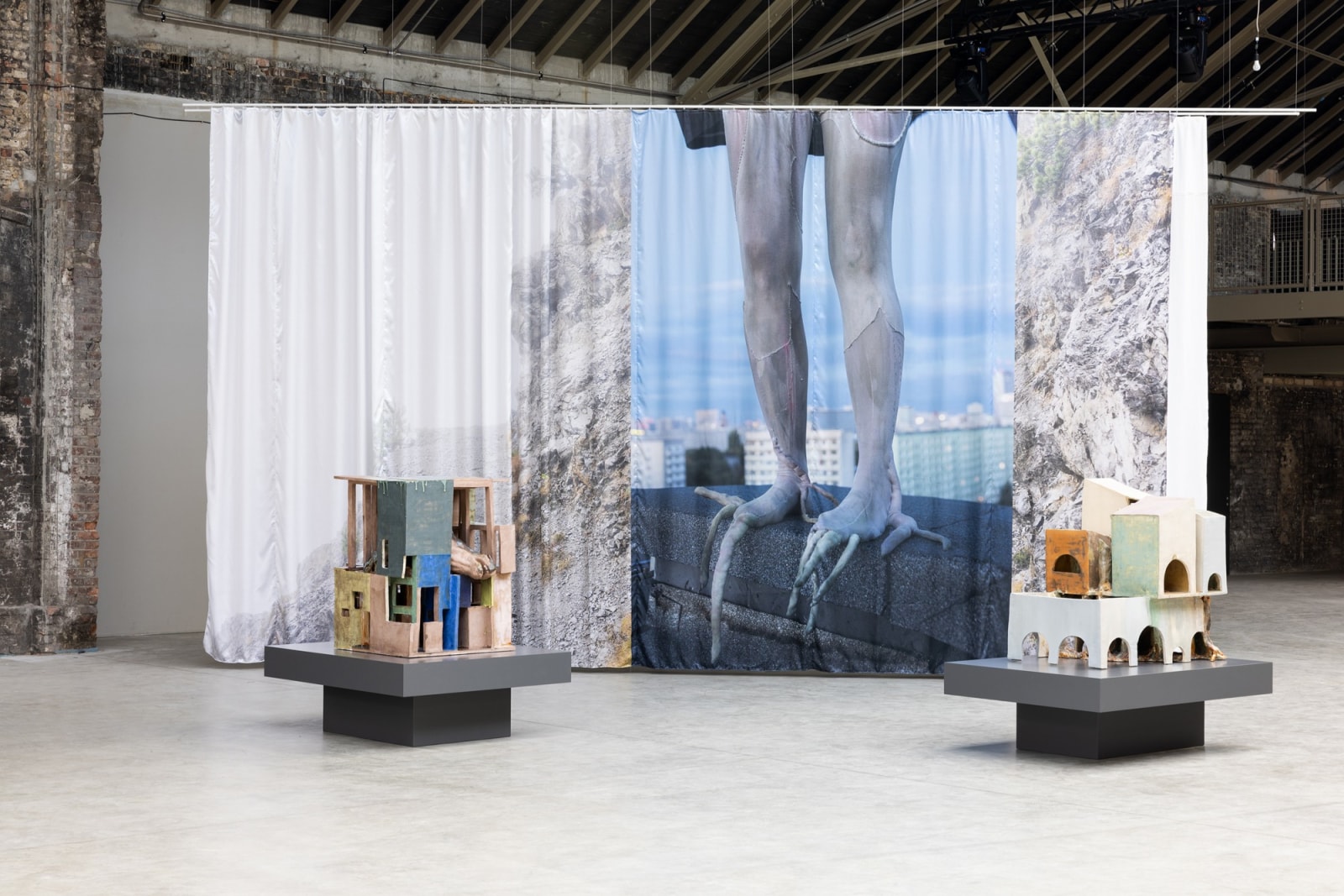
| Back: Isa Melsheimer, Curtain (Höhenweg), 2020, satin curtain, embroidery, 416 x 790 cm.
Front left: Isa Melsheimer, false ruins and lost innocence 3, 2020, ceramic, plinth, 101 x 105 x 79 cm (work)
50 x 120 x 140 cm (plinth).
Front right: Isa Melsheimer, false ruins and lost innocence 1, 2020, ceramic, plinth, 104 x 80,5 x 122 cm (work)
50 x 160 x 110 cm (plinth).
Exhibition view: K60 with Isa Melsheimer, Wilhelm Hallen, Berlin, 2022. Photo © Andrea Rossetti | |
|
K60 With Isa MelsheimerWilhelm Hallen Kopenhagener Strasse 60-72 13407 Berlin Through September 18, 2022 www.wilhelm-hallen.dewww.estherschipper.com
A solo presentation by Isa Melsheimer at K60 will include large-scale ceramics, textile works, and gouaches. The ceramics draw on existing buildings and fill these architectural structures with unexpected sculptural details and colorful glazes that evoke fantastic microcosms, a world in which it is not at all surprising that tree stumps grow in houses and buildings incorporate human and non-human elements. Tickets available hereVisitor information:Friday September 16, 1-8pm Saturday September 17, 11am-8pm Sunday September 18, 10am-8pm
|
|
|
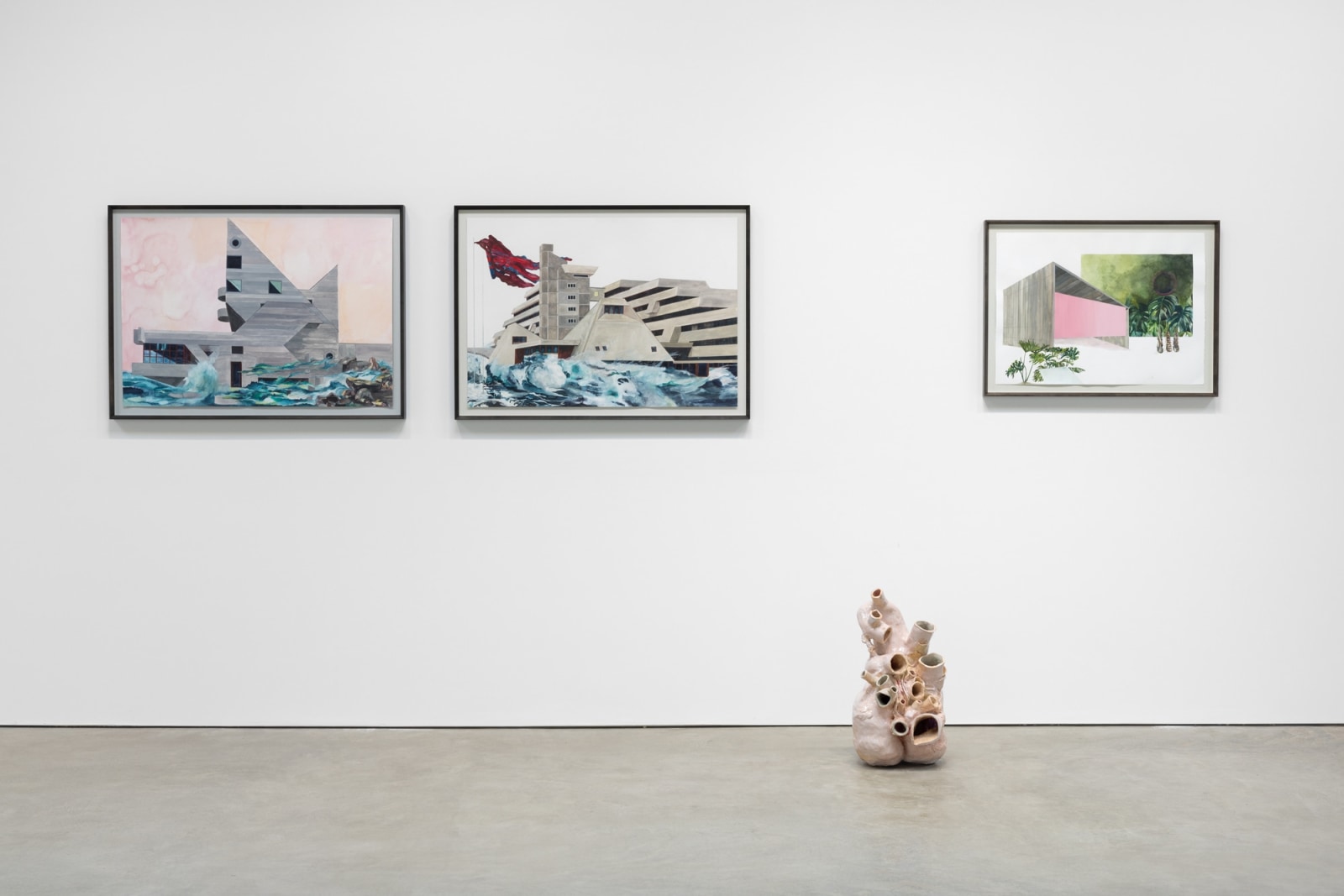
| Exhibition view: K60 with Isa Melsheimer, Wilhelm Hallen, Berlin, 2022. Photo © Andrea Rossetti | |
|
As part of this year's Berlin Art Week a number of exciting events and projects by our artists are taking place across town.
|
|
|
Jean-Pascal Flavien
make-up house
|
|
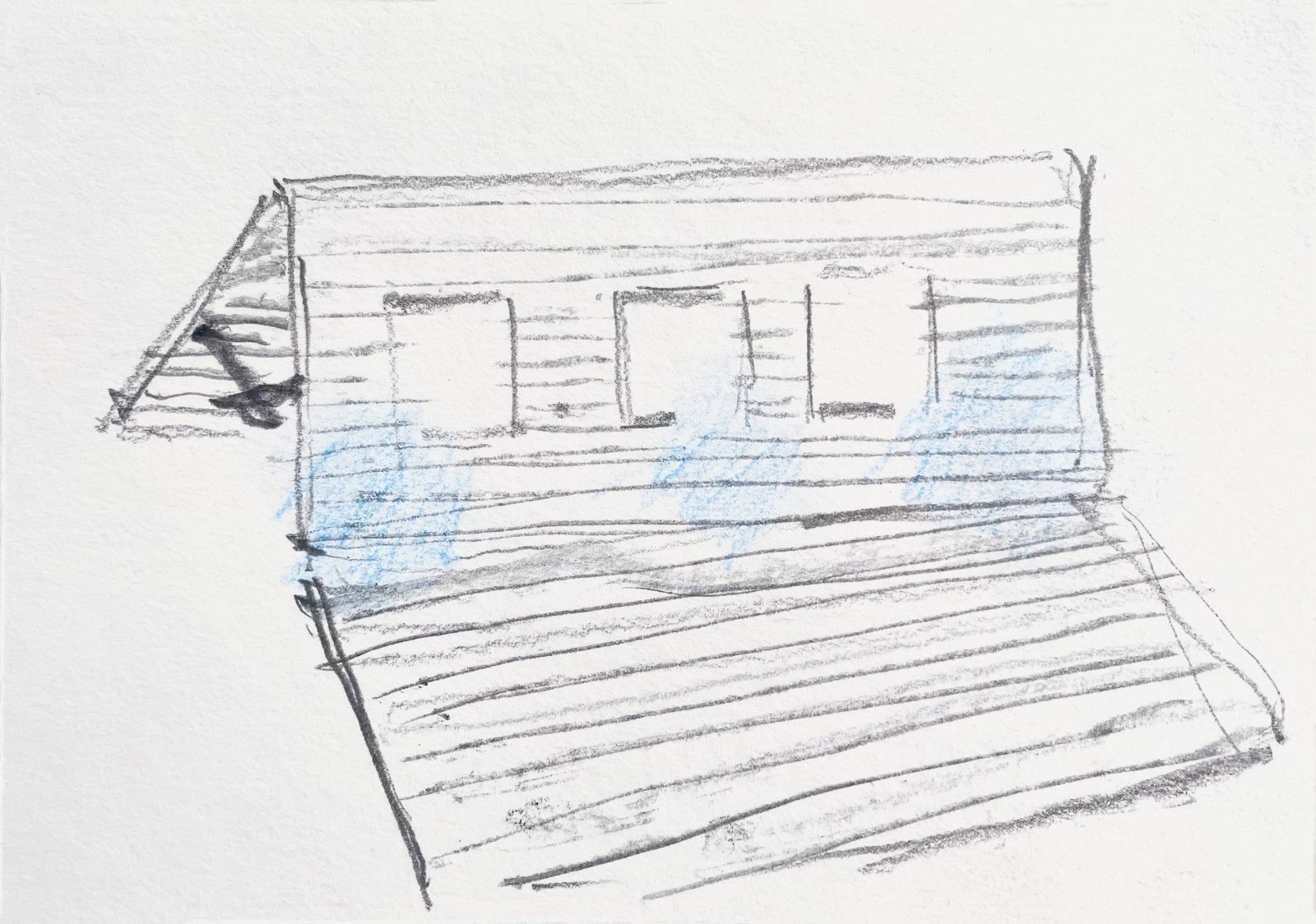
| Jean-Pascal Flavien, Make-up House (drawing), 2022. Photo © the artist | |
|
Jean-Pascal Flavien
make-up house
San Gimignano Lichtenberg
Am Wasserwerk 22F
10365 Berlin
Opening: Saturday September 17, 2-7pm
www.estherschipper.com
Jean-Pascal Flavien’s make-up house will open at San Gimignano Lichtenberg, Arno Brandlhuber’s architectural site in Berlin.
For Berlin Art Week make-up house will be open Saturday 17 and Sunday 18, 2-7pm.
Jean-Pascal Flavien’s new house, entitled the make-up house, is all surface. Sheets of corrugated metal folded to create a sheltering space, the house is open to the elements, with a small area to inhabit—just enough space to put on some make-up. Equipped with a small desk, a mirror and a selection of cosmetics, special guests will be invited to propose and make a maquillage for the house. Each of these will be applied temporarily to the facade. Simultaneously a person can make up their own face in a similar fashion. The recurring events are ephemeral, lasting from a day to a few weeks. The house will live the life of a surface, existing by making appearances.
Architectural discussions have long focused on form and function, whether a structure’s surface should reflect its construction process and/or its purpose. Flavien’s house takes another approach: drawing attention to the role surfaces play in daily life, fashion and building, focusing on the lightness created by the ephemeral. The Make-up house will change according to the newest maquillage, its existence will be located in the eyes of others. Existing in the surface could be a motto for a building.
Continuing beyond Berlin Art Week, Flavien’s project will include collaborations with Bless, Sam Chermayeff, Dominique Gonzalez-Foerster, Karl Holmqvist, and Christopher Roth.
The buildings are located on a construction site. Access is restricted to the immediate environs of the make-up house. Entrance to the site is at your own risk.
|
|
|
About San Gimignano Lichtenberg
San Gimignano Lichtenberg started as a collaboration between Brandlhuber+ Georg Diez, Nikolai von Rosen and Christopher Roth.
Find via Google maps
The buildings are situated between the Dong Xuan Center Vietnamese wholesale market and GDR Plattenbauten (prefabricated high-rise buildings).
The two concrete towers, previously used as a silo and a circulation tower, are the remnants of the VEB Elektrokohle Lichtenberg, a state-owned factory for graphite production. After the Berlin Wall had come down, the site was abandoned until the late 1990s when the area was privatized to raise money for the city-state. The former production site was demolished; only the two concrete towers remained due to their high cost of demolition. The towers acquired their name from their lacklustre site. By associating them with the towers of the town San Gimignano near Florence, their perception has been altered using the power of narrative. The concept envisages the reuse of the existing towers with little effort and intervention, mainly focusing on returning it to a legal status and adapting it to the requirements of a new program, which aims at transforming the site into a new productive nucleus for architectural prototyping.
By bplus.xyz
|
|
|
Summer Festival at FAHRBEREITSCHAFT
with Ari Benjamin Meyers
|
|
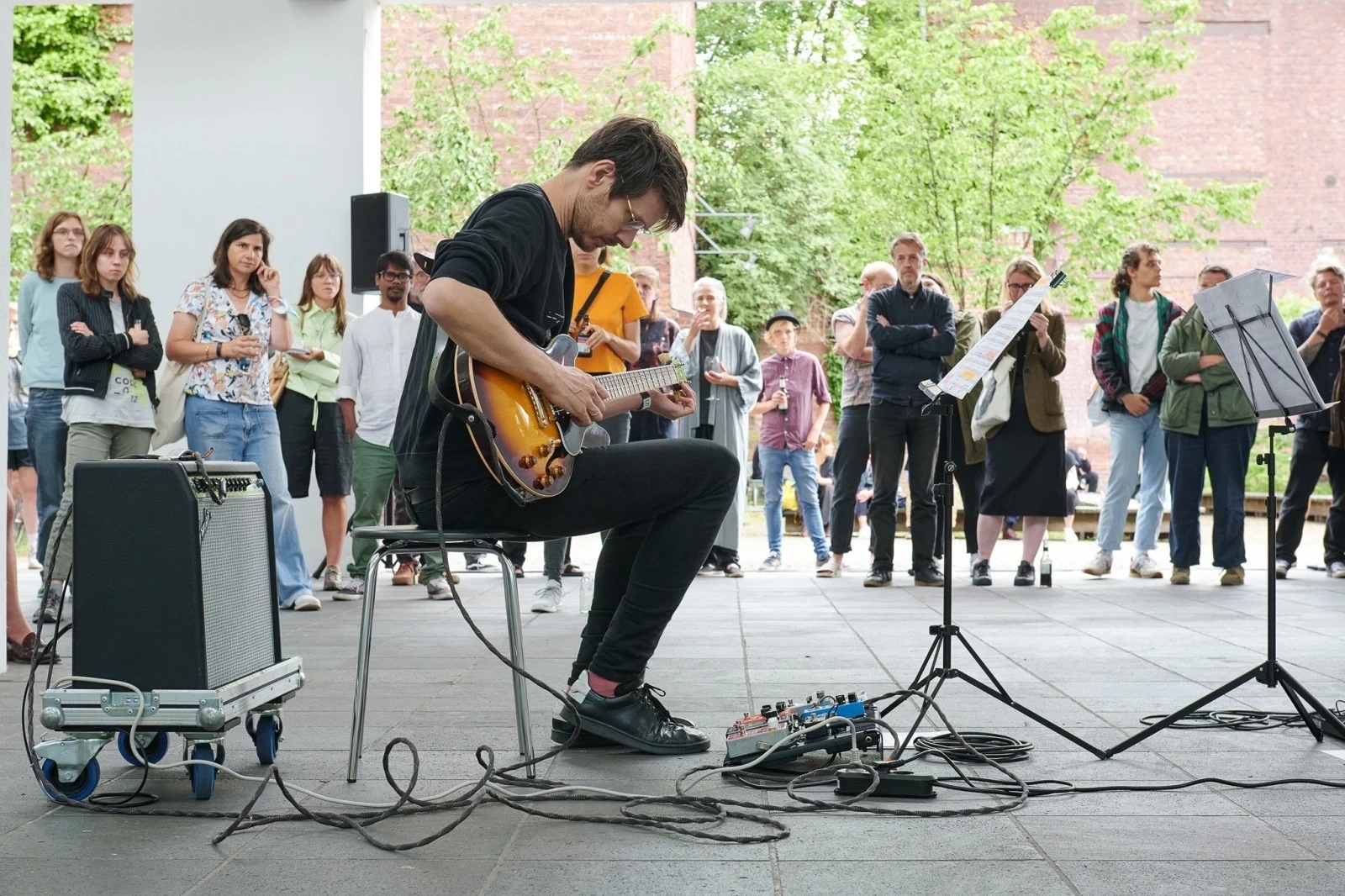
| Ari Benjamin Meyers, Serious Immobilities, 2013, performance protocol, music score for electric guitar, electric bass and voice, duration variable.
Photo © Mareike Tocha and Cold Summer, a festival by Keren Cytter and Ludwig Forum Aachen, with Jan Terstegen (Guitar) and Thomsen Merkel (Bass), 2022. | |
|
Summer Festival at FAHRBEREITSCHAFT With Ari Benjamin Meyers, Thomsen Merkel and Nico van Wersch FAHRBEREITSCHAFT, Berlin Saturday, September 17, 2022, 4pm-2am www.haubrok.orgFrom 5:45–6:30pm on September 17, Thomsen Merkel and Nico van Wersch will perform Serious Immobilities (Module 4/instrumental version), a composition by Ari Benjamin Meyers to be performed in an exhibition venue. The piece originally consisted of 9 flexible modules lasting 6-8 hours and was scored for voices (minimum 3, un-amplified), electric guitar and electric bass. This performance is an excerpt from Module 4 in a version for electric guitar and bass alone. The title Serious Immobilities is a tongue-in-cheek reference to the instructions that Erik Satie wrote on the score of his composition Vexations: "In order to play the theme 840 times in succession, it would be advisable to prepare oneself beforehand, and in the deepest silence, by serious immobilities." Concurrently, the haubrok collection present something in the air, through October 29. For the exhibition the sound works from the haubrok collection are distributed both indoors and outdoors. on view are artworks by Phil Collins, Martin Creed, Jason Dodge, Isa Genzken, Rodney Graham, Pierre Huyghe, Emily Jacir, On Kawara, Jonathan Monk, Ayumi Paul, Susan Philipsz, Peter Piller, Stephen Prina, David Shrigley, Anri Sala, Johannes Wohnseifer, Heimo Zobernig
|
|
|
Open Studio – Karin Sander
|
|
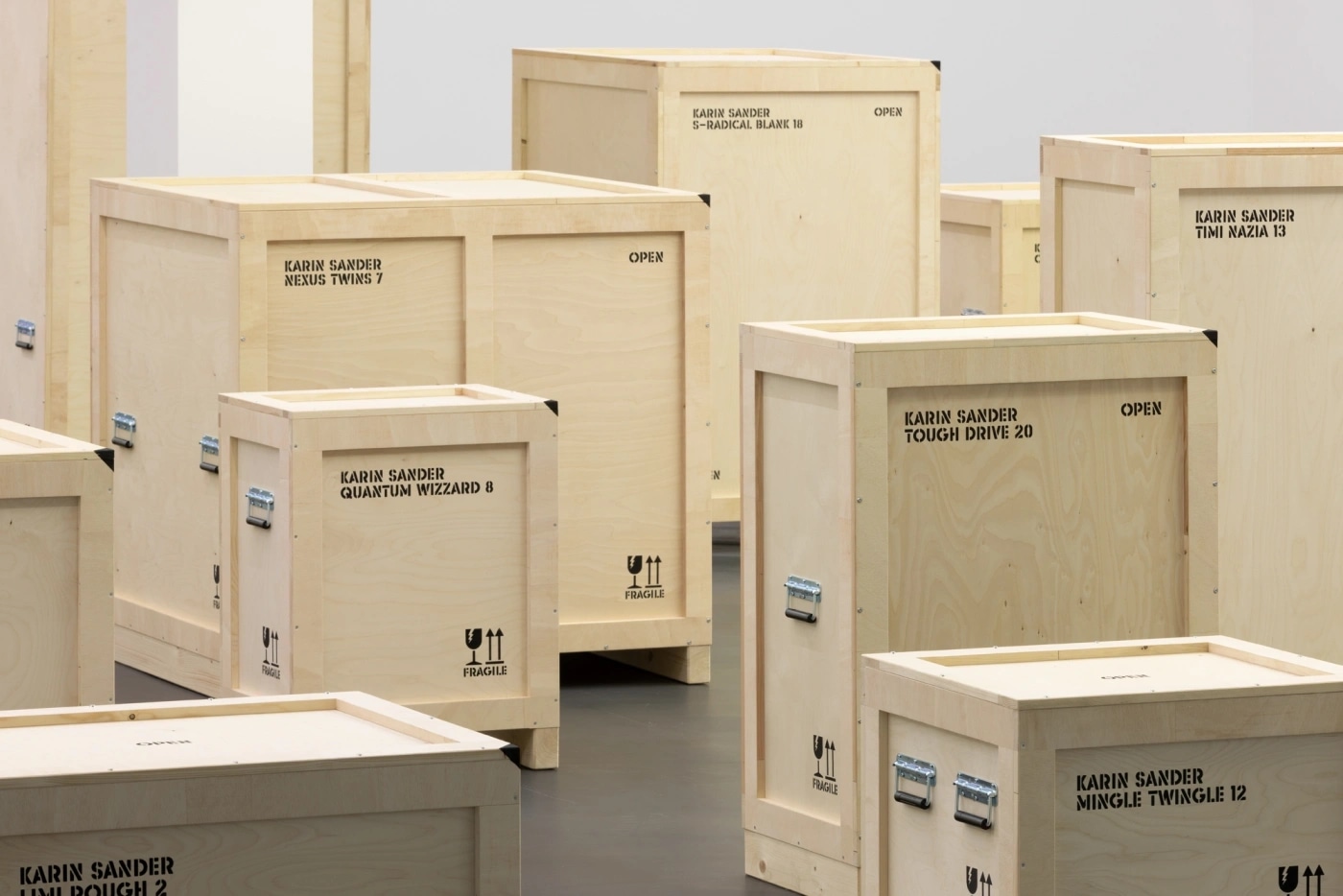
| Exhibition view: Karin Sander, "What you see is not what you get" (22 exhibitions), Esther Schipper, Berlin, 2022. © Karin Sander / VG Bild-Kunst, Bonn 2022. Photo © Andrea Rossetti | |
|
Open Studio – Karin SanderWerkhof L57 Lehrter Straße 57 10557 Berlin Friday, September 16, 2022, 5-8pm www.karinsander.deWithin the framework of Berlin Art Week, studios on the grounds of Werkhof L57 open their doors. With Karin Sander (House 2), Studio Van der Velden, Atelier David Möller/Frederic Spreckelmeyer (House 3), Studio Via Lewandowsky (House 4), Studio Regina Schmeken, René Schmitt (House 6), Studio Paola Yacoub, Architekturbüro Engelbrecht (House 9).
|
|
|
Die Tore
with Rosa Barba and Karin Sander
|
|
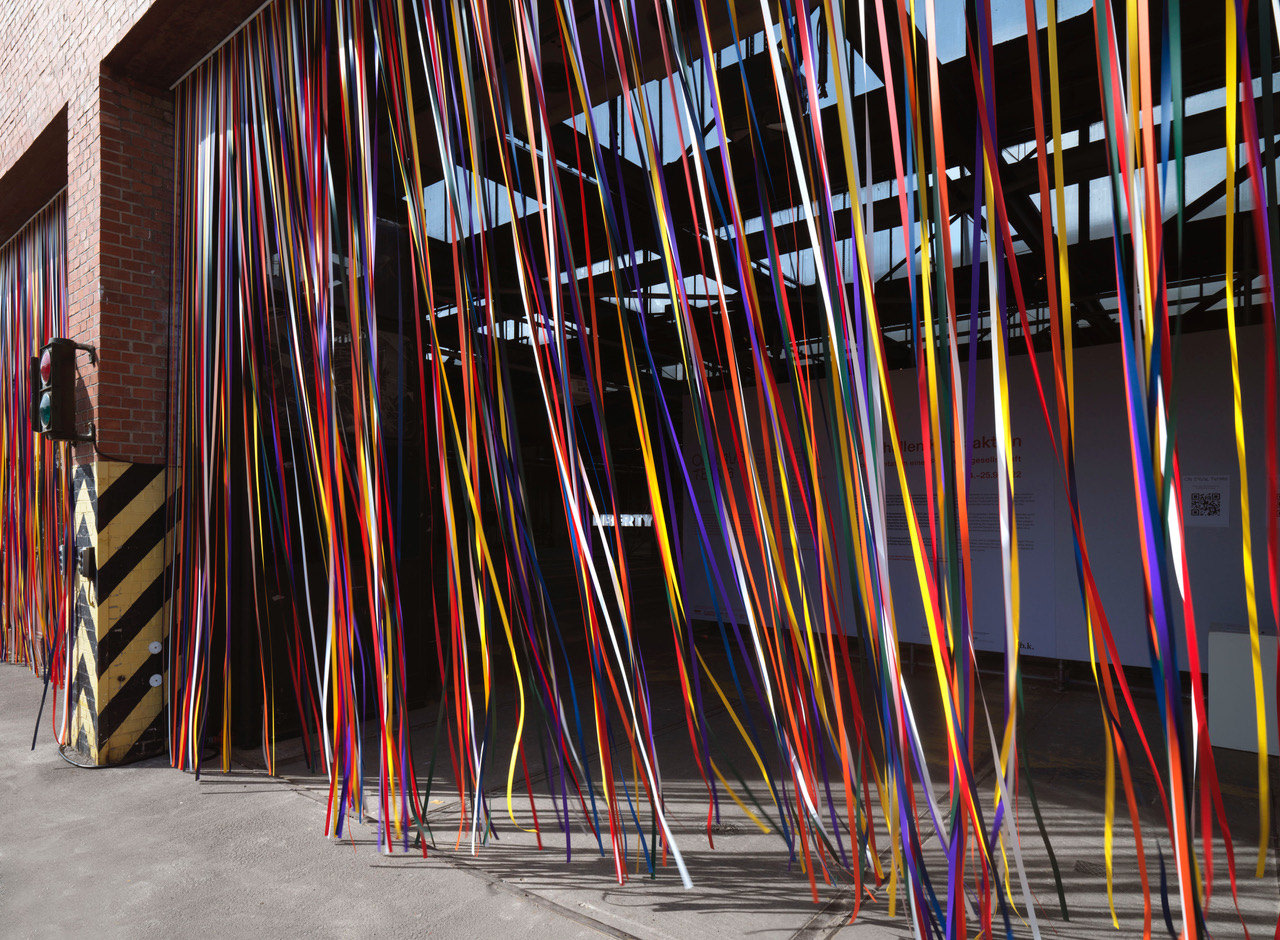
| Karin Sander, Zwei Fliegenvorhänge, 2022, vinyl, 1270 x 445 cm
© Karin Sander / VG Bild-Kunst, Bonn 2022
Produced by Neuer Berliner Kunstverein (n.b.k.) and Berlin Art Week. Photo © Jens Ziehe
| |
|
Die Tore With Rosa Barba and Karin SanderUferhallen Uferstraße 8 13357 Berlin September 14—25, 2022 www.berlinartweek.deOn the occasion of Berlin Art Week, the exhibition will be open from Wednesday, September 14—Sunday September 18, 2022, from 12-10pm. Sound installation by Rosa Barba: every day from 10am-3pm With its exhibition on the history of the Kunstaktien, n.b.k. traces the development of Uferhallen and the genesis of the Kunstaktien project. Kunstaktien by all participating artists will be shown. At the same time, the exhibition On Equal Terms by Uferhallen e.V. is on view at Uferhallen, providing insight into the production processes of its resident artists. At the invitation of n.b.k. and in collaboration with On Equal Terms and the Berlin Art Week, site-specific works by Rosa Barba, Maria Eichhorn, Herta Müller, and Karin Sander will also be on display at the Uferhallen entrance gates under the title Die Tore.
|
|
|
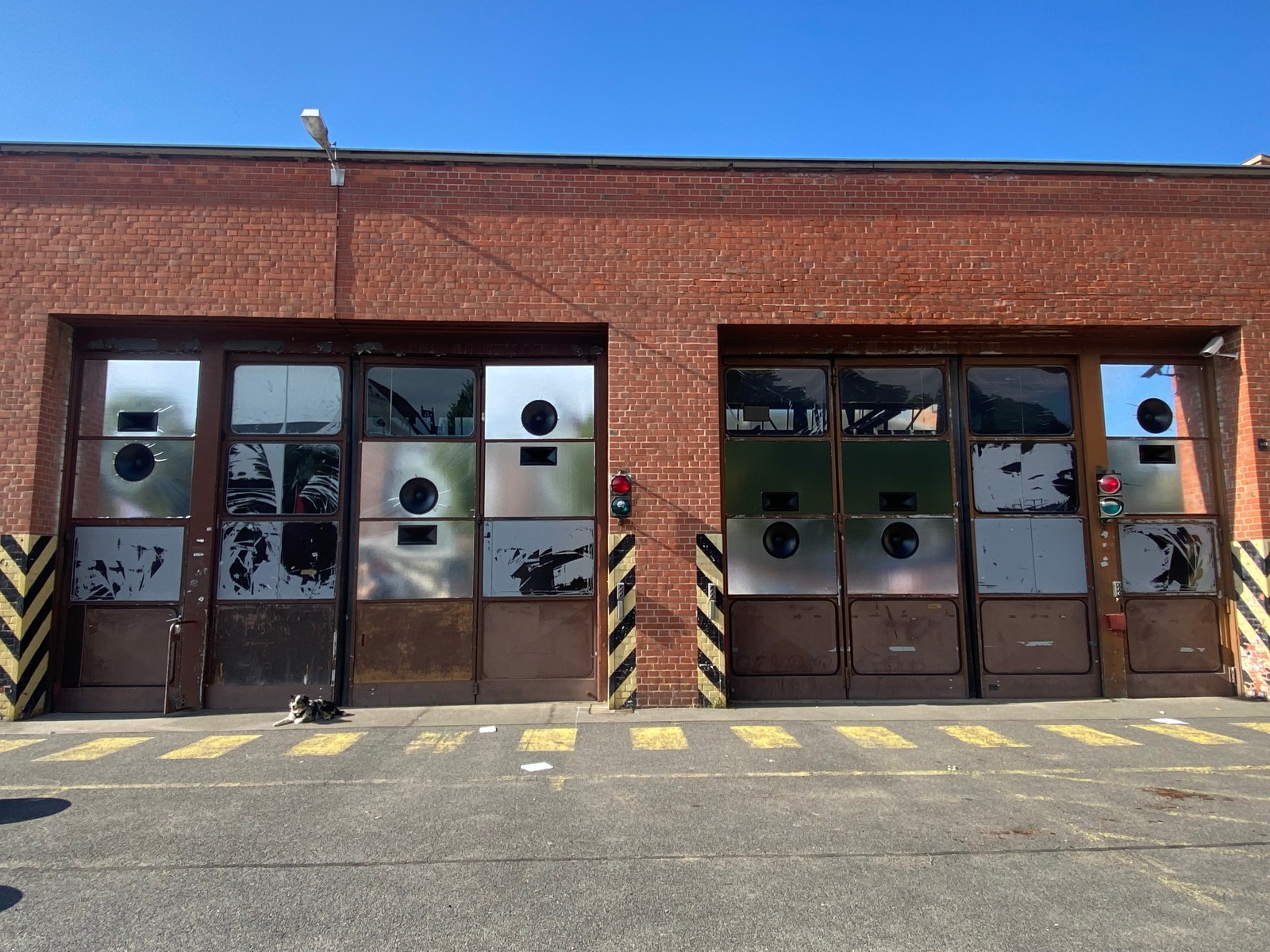
| Rosa Barba's sound installation Rosa Barba will play every day from 10am-3pm during Berlin Art Week.
Rosa Barba, Behind the Broadcast, 2022. © the artist / VG Bild-Kunst, Bonn 2022.
Photo © the artist. | |
|
#145: What should I call it?
with Ceal Floyer
|
|
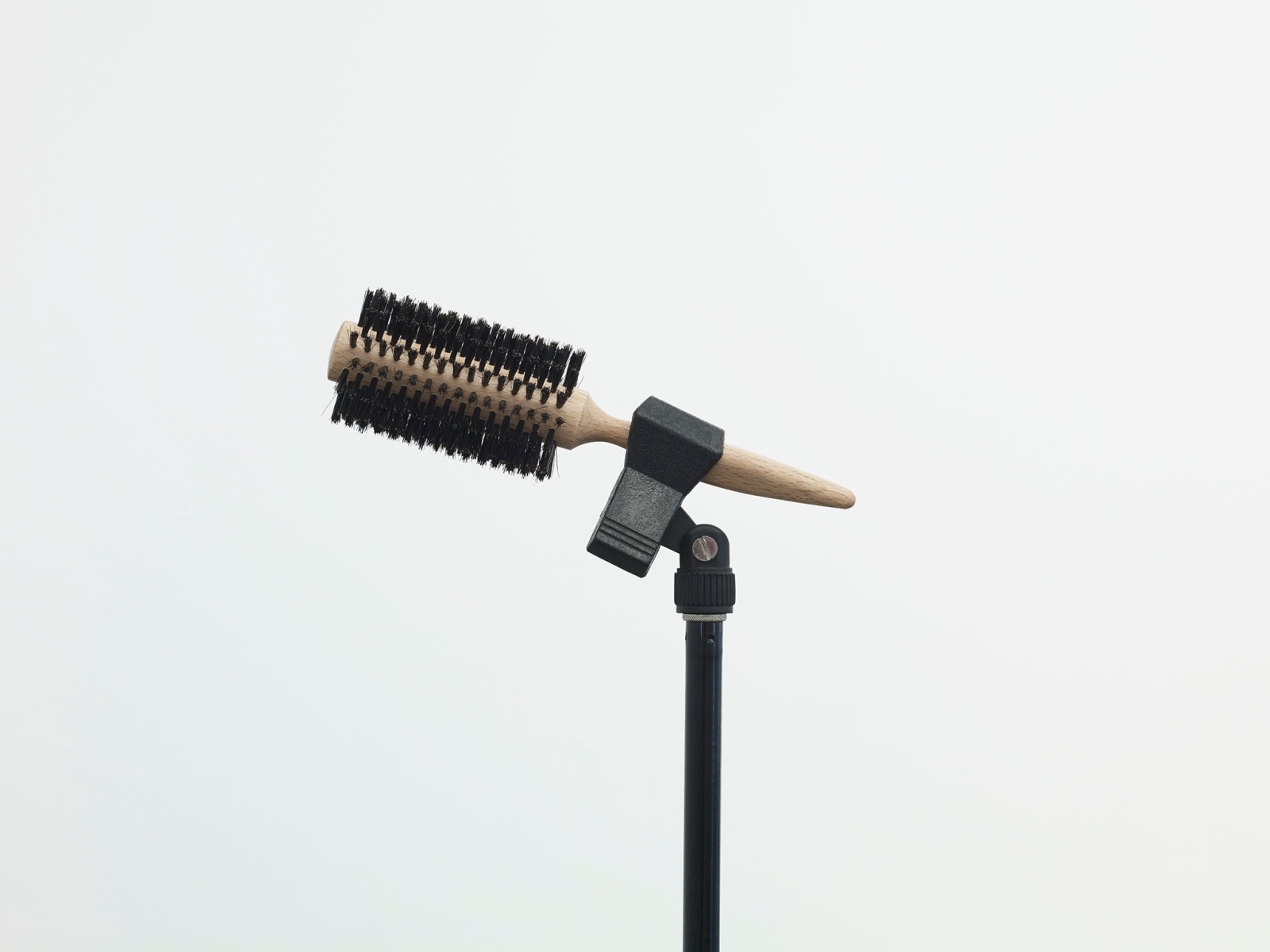
| Ceal Floyer, Solo, 2006, microphone stand, hairbrush. Photo © Tony Prikryl
| |
|
#145: What should I call it? With Ceal FloyerStudio Christian Jankowski Reinbeckstraße 43 12459 Berlin September 15—18, 2022 Opening: Thursday September 15, 5-9pm DirectionsThis group exhibition, including Solo, 2006 by Ceal Floyer, tackles naming and titling as art practices that involve a personal, contextual, and subversive approach to creating an alleged identity. Solo consists of a microphone stand that holds a hairbrush instead of a microphone. The juxtaposition of objects intended for private and for public use draws attention to the usual separation of these two realms. Because of the similarity in the shape of brush and microphone, the visitor needs to come relatively close in order to notice the switch. The play with expectations and the misuse of technical equipment (in effect, removing or subtly subverting its intended function) are continuous themes in Floyer's work. Perhaps the overt reference to private preparations for a public performance is also in response to the artist's performance piece, the Nail Biting Performance she staged at Symphony Hall, Birmingham on February 7, 2001 and immediately preceding the official press conference of the 2012 dOCUMENTA 13 in Kassel. |
|
|
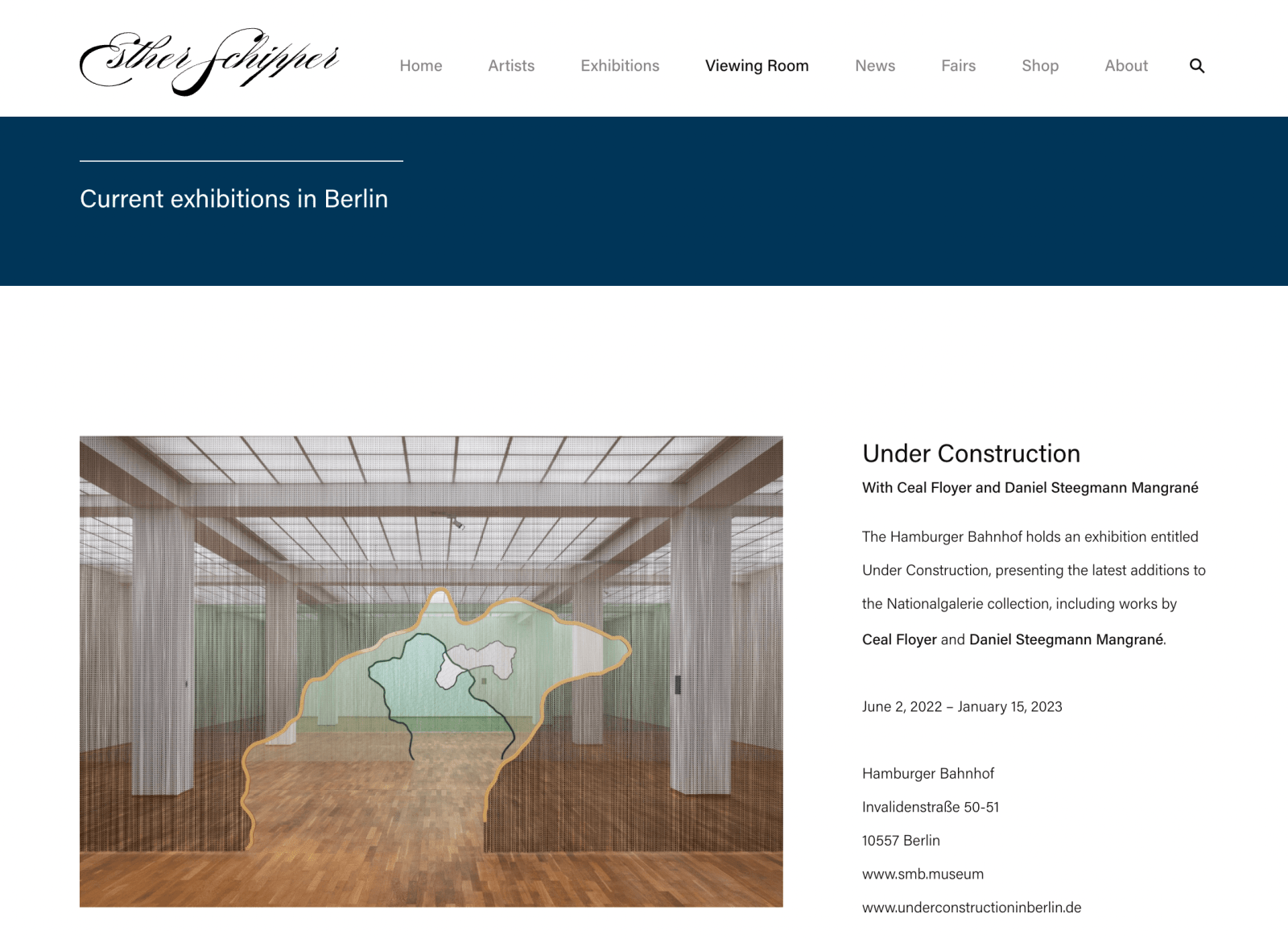
| Current exhibitions in Berlin | |
|
Rosa Barba
On the Anarchic Organization of Cinematic Spaces - Evoking Spaces Beyond Cinema
2021
Publisher: Hatje Cantz
Language: English
Available here
|
|
Rosa Barba
From Source to Poem
2017
Publisher: Hatje Cantz
Language: English, Italian
Available here
|
|
Rosa Barba
Time as Perspective
2013
Publisher: Hatje Cantz
Language: English
Available here
|
|
Rosa Barba
White is an Image
2011
Publisher: Hatje Cantz
Language: English, Italian, French
Available here
|
|
Ceal Floyer
A Handbook
2015
Publisher: Hatje Cantz
Language: German, English
Available here
|
|
Jean-Pascal Flavien
Philothée Gaymard, inhabitant of the Rietveld-Schröder house
2018
Publisher: Onestar Press
Language: English
Available here
|
|
Isa Melsheimer
Need for Contrast
2015
Publisher: Verlag für moderne Kunst
Language: German, English
Available here
|
|
Ari Benjamin Meyers
Tacet in Concert
2019
Publisher: Corraini Edizioni
Language: English
Available here
|
|
Karin Sander
Skulptur / Sculpture / Scultura
2020
Publisher: Verlag der Buchhandlung Walther König
Language: Italian, English, German
Available here
|
|
Daniel Steegmann Mangrané
The Spiral Forest
2018
Publisher: The Green Parrot and Mousse Publishing
Language: English
Available here
|
|
|
ESTHER SCHIPPER
POTSDAMER STRASSE 81E
10785 BERLIN
|
|
|
|
|
